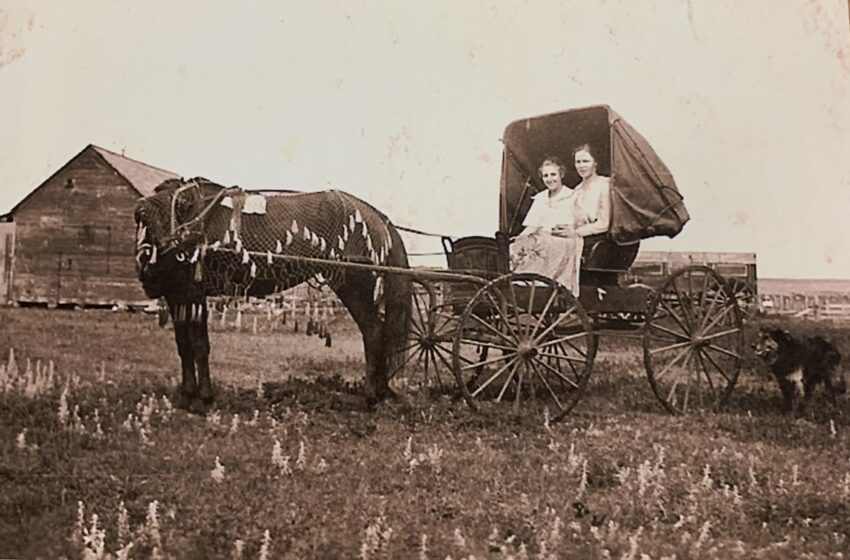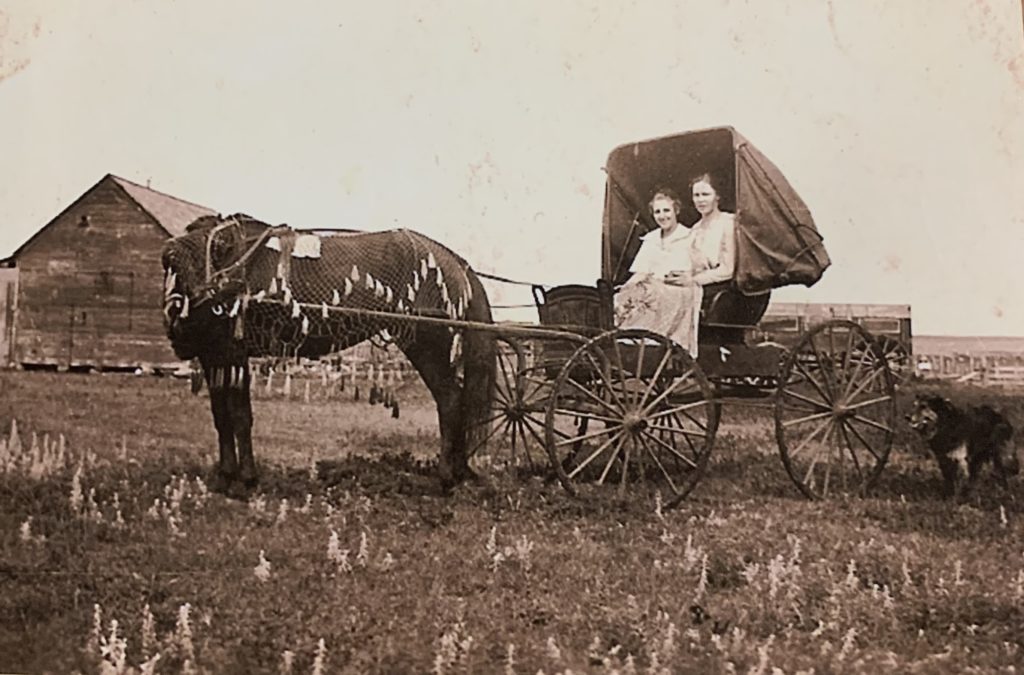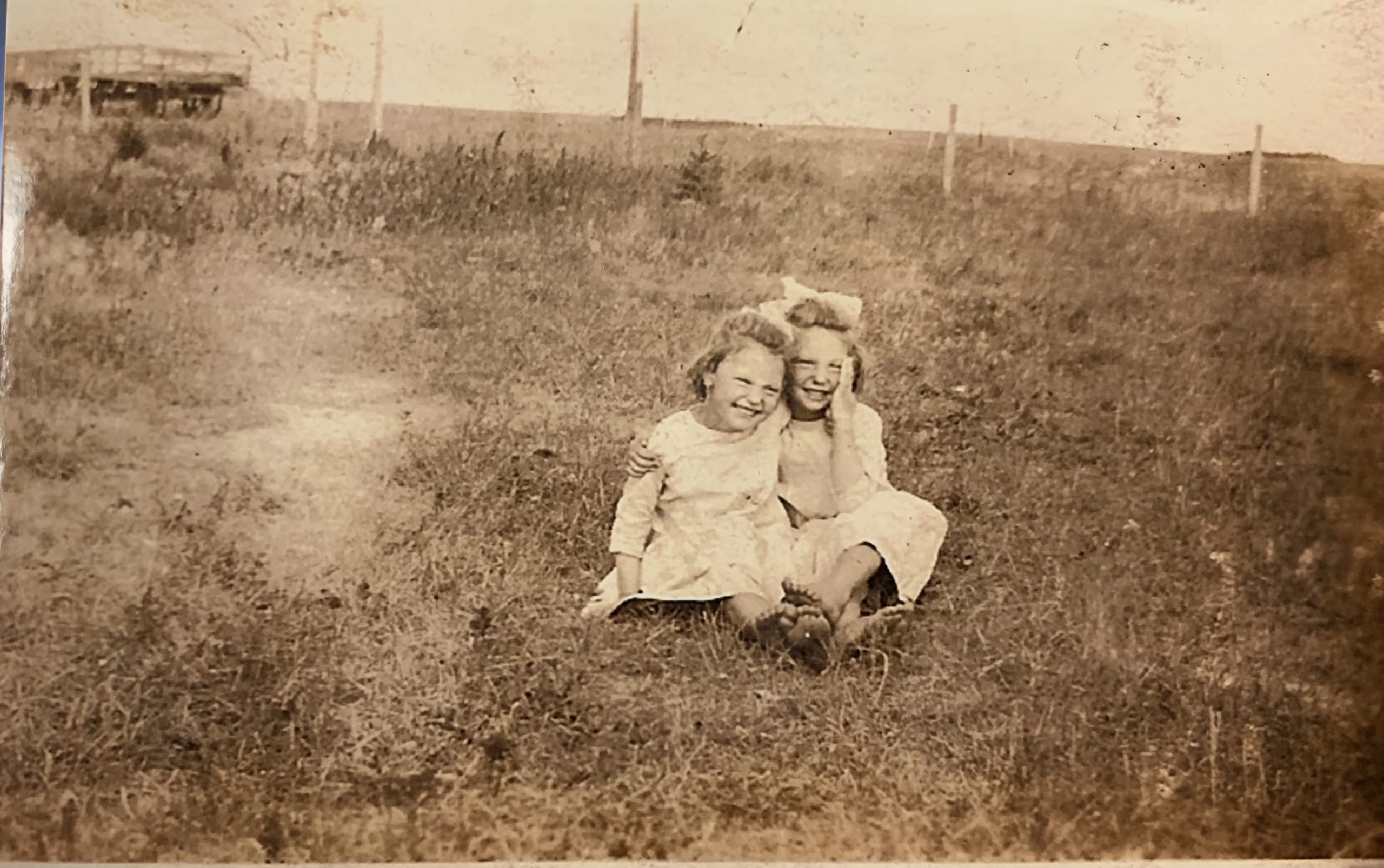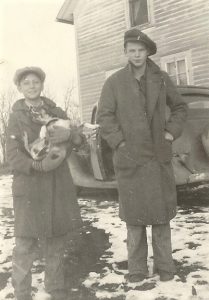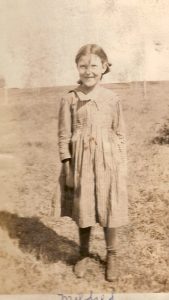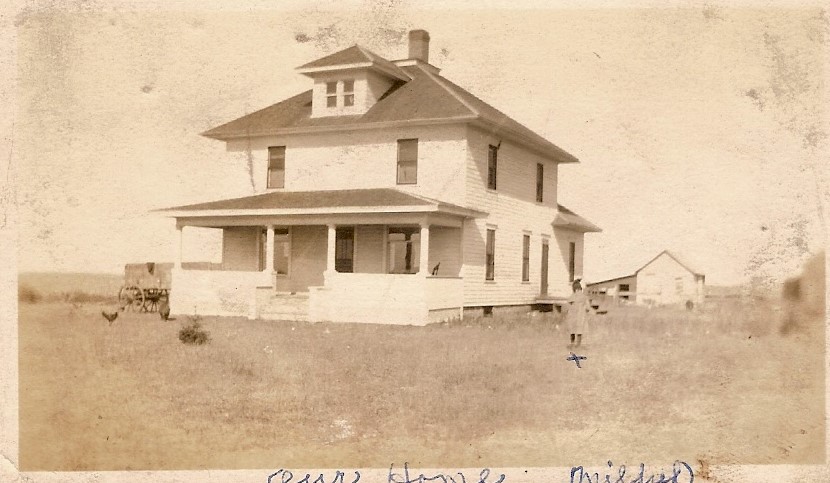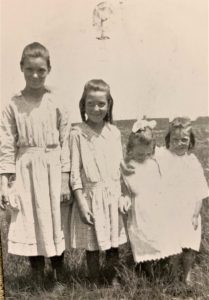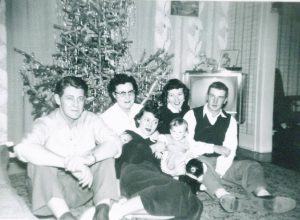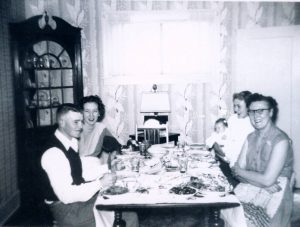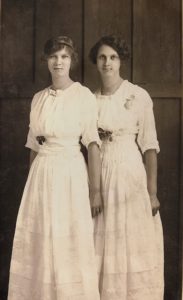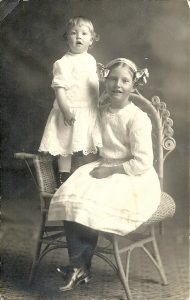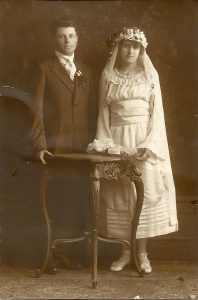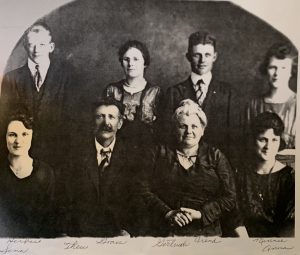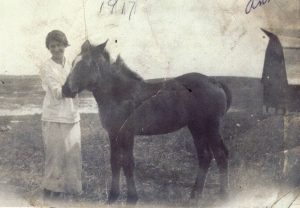By Mary Fairchild
The unique stories of our ancestors open up our knowledge of history with greater detail in rich and heart-warming ways. Please enjoy my latest compilation of ancestor letters, notes, and photographs that I have been graciously supplied with. A special thanks to my sister-in-law, Kathy Nicholls, who spent countless hours making copies with me so that we could share these priceless memories with others. I would also like to express my gratitude to my late parents and Uncle Joe, as well. Along with their personal stories, they also encouraged me to scan and copy family notes and photographs as they helped me for hours detailing their personal memories. A collection of my genealogy pictures and documents are still in the process of being uploaded, but they can be found, in part, online at Mfairlady Flickr Albums.
Life on the Prairie; The Story of My Life by Mildred Fransen; The Best of Times by Shirley Holmstrum; Kepler Descendants in America; The First Pioneers in Ohio; The Early Settlers of Iowa; Stemple Family Descendants; Fransen Family Descendants; Native American Spirituality; His Story; Timeline.
Life on the Prairie
The Great Plains were challenging for the early settlers. The only way to get across the Mississippi River, for example, was to traverse before the ice breaks. It was not only difficult to move belongings to the Great Plains, but poor road systems made transportation difficult getting in and out of towns.
When the Ohio and Erie Canal was built between 1825-1832, it opened up the rest of the settled eastern United States. It provided a successful transportation route from Cleveland on Lake Erie to Portsmouth on the Ohio River.
The Pacific Railroad Act of 1862, thirty years later, also promoted the settlement in the West. Many of the routes that the railroads followed were the line of the same trails that the Indians used in their expeditions against the early settlers. Earlier emigrants west of the Mississippi River, never hesitated to follow an Indian or buffalo path, certain it would lead by the most direct accessible route to its destination. In later years they served as highways to the pioneers seeking future homes.
Alfred Kepler, Eliza (pregnant with Ida) and Isaac arrived by oxen drawn covered wagon from Indiana in October of 1868 and Ida was born a month later, around Stanhope, Iowa. Mary Jeanette Anderson, granddaughter of Lizzie Kepler
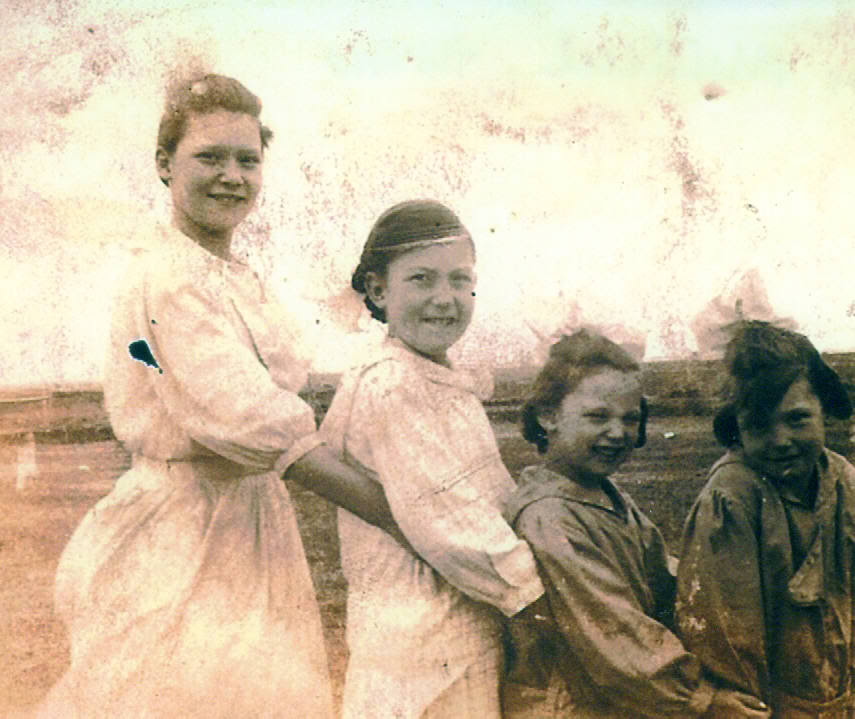
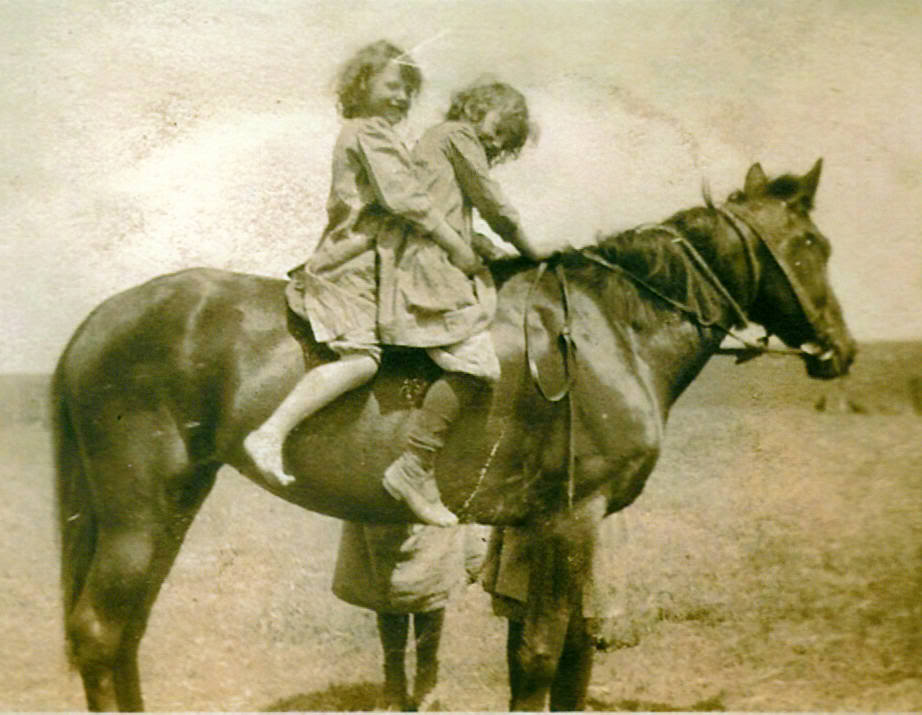
As the people were settling the Mid West/Great Plains there were more conflicts because the Native Americans in this area often relied on hunting buffalo and a lot of them were nomadic. The Homestead Acts were an expression of the free soil policy of Northerners who wanted individual farmers to own and operate their own farms, as opposed to Southern slave-owners who wanted to buy up large tracts of land and use lave labor which would shut out free white farmers. (3)
The settlers did not hate the Indians so much as they hated the wolves. It was recalled that the wolves howled around the house all night till it felt like the clap-boards on the roof were shaking. The settlers would plow all day with a horse and guard the animal all night to protect it from the wolves. Finally, the state offered a bounty for each wolf scalp, and the howling tribe of the forests commenced to decrease in numbers. Scott Eike, great-grandson of Alta Mae (Kepler) Stemple(2)
Willard loved to hunt arrowheads and Indian hammers (Darrow & Willard pictured). He really had a nice collection. He looked for them all over. We had Indian mounds at Spirit Lake, South Dakota. The story was many Indians were buried there. Mildred (Stemple) Fransen
Laura Ingalls’ stories of America’s life on the frontier often stressed the value of “time away from the crowds” to not be drawn into their way of thinking. From the mid-seventies through the early eighties, the Little House on the Prairie television series encouraged American families as Laura’s life on the prairie illustrated a loving and strong pro-family example. Her father was not only hard working, but also ran a patriarchal household where he did not overrule his wife and children, but was loving and respectful. Rather than government granted, liberty and equality merely required hard work, honesty and a set of solid values. The father worked in a mill or on a farm and his children went to school and did their chores. The wife worked as hard as the husband running the household and she often sold eggs contributing to the family’s income.
But I’ll never forget the days when we had to can meat and fry down the lard. We, or should I say mother, raised enough chickens so she would have eggs to take to town to buy groceries which was usually a 100 pound sack sugar, the largest sack of flour, coffee and tea. We also used our cream money for groceries. My mother baked loaves of bread every other day, then she baked white sugar cookies and buns. Mildred Fransen
Sometime, when the bread came out of the oven, the twins and I would snitch a loaf that was still hot, along with butter, a jar of homemade strawberry sauce and go to the pasture and eat it. It was so good I can still taste it. I guess we were little devils. My job at home was to gather eggs and milk cows—usually the twins and I had that job. I started milking when I was 6 years old and milked cows until I got married. So, you see, I’m and old milk hand. We raised all our own potatoes which we always had to pick up and put in the large lumber wagon. We’d have several wagon loads. We never bought potatoes. We raised our own navy beans–Mildred (Stemple) Fransen, daughter of Alta Mae (Kepler) Stemple
Grandpa and Grandma shopped at Loftus Store (of Little House on the Prairie fame), as did everyone else. Mary Jeanette Anderson–Lizzie Kepler’s granddaughter
Our mother sewed all our clothes. We usually had one good dress that we wore to church and Sunday school. We wore one dress to school a week, but we always changed clothes when we got home–Mildred (Stemple) Fransen, daughter of Alta Mae (Kepler) Stemple
Laura Ingalls shared with Deadwood Magazine that she was amazed with how well her books had been received especially since she never really graduated from anything, but only attended ‘little red schoolhouses’ all over the West. (4)
My childhood was a happy one. We had wonderful parents–their interest was their family. There was no favorites with my parents. They always showed their love and appreciation. We never had too much in material things, but I wouldn’t trade all the wealth in the world for that kind of relationship. Mildred (Stemple) Fransen, daughter of Alta Mae Kepler
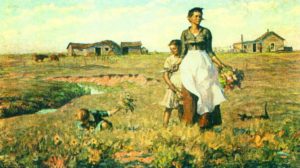 Paintings like “The Prairie is My Garden” (pictured), “Something for Supper,” and “Buffalo Bones are Plowed Under” all portrayed the era of homesteading on the middle border. The artist, Harvey Dunn, insisted that the painter needed to paint things as they really are and his prairie scenes needed no explanations. He painted the raw country, tough pioneers and hard work just as he remembered them. Harvey Dunn was born on March 7, 1884 in a claim shanty near Manchester, South Dakota. (6)
Paintings like “The Prairie is My Garden” (pictured), “Something for Supper,” and “Buffalo Bones are Plowed Under” all portrayed the era of homesteading on the middle border. The artist, Harvey Dunn, insisted that the painter needed to paint things as they really are and his prairie scenes needed no explanations. He painted the raw country, tough pioneers and hard work just as he remembered them. Harvey Dunn was born on March 7, 1884 in a claim shanty near Manchester, South Dakota. (6)
As for Harvey Dunn’s home… I can remember when we spent two nights at Geo and Minnie’s. Herb helping dig a well on the Harvey Dunn’s place. The guy who dug the well was trying to make me feel how little in his standards that I had. His wife had a vacuum cleaner which we didn’t have. Do you suppose that’s why I have three now? All in all I summed up my life as a pretty good life. Sure bad times and good times. Isn’t that what its all about? Mildred (Stemple) Fransen, daughter of Alta Mae Kepler
The Story of My Life by Mildred Fransen
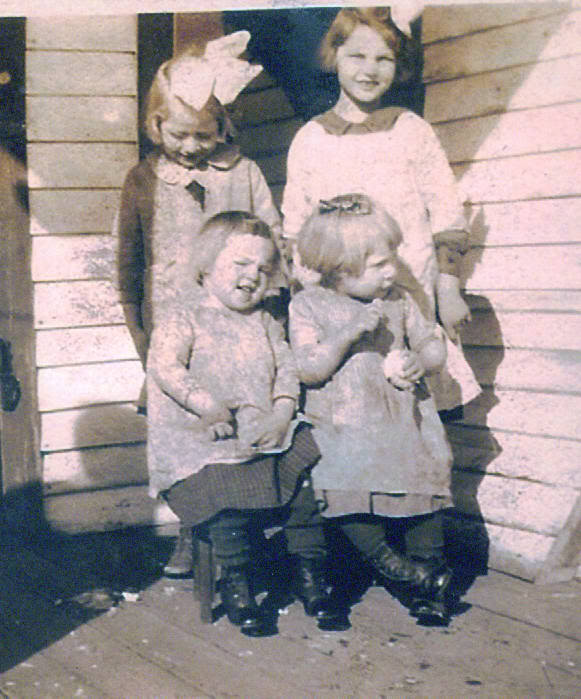
Back to our home–I will never forget how beautiful it looked to me. A large house–all new and shiny. I can’t recall how old I was when we moved there. But I would think about 6 years because the twins were 2 1/2 -3 years old. When we got in the house I remember I went from one room to another and the twins kept running upstairs. We had a large parlor, and a large bedroom, and a large dining area. A large kitchen and a pantry and a washroom with 3 porches downstairs. Four large bedrooms and a large hallway upstairs. I can remember those pretty rugs we had in our bedroom downstairs and in the parlor with the french doors. Mom kept the parlor closed off only when company came. She and dad always had a big interest in our home. It was really quite nice for having a large family.
Our folks worked very hard, but they wasn’t temperamental. My mother raised chickens and turkeys and always had a large garden. She canned so much our basement in the fall looked like a grocery store. Everything had to be canned because we wouldn’t have refrigeration or ice boxes. To keep our butter cool (we churned our own butter) we hung the butter down in a cistern which was underneath the pantry floor to keep it cool. My mother had a large strawberry patch. I can still remember the shortcake she made. It was made out of sweet cream biscuit dough recipe. She would make two 9×12 pans, put one layer on the bottom, strawberries in between and also on the top layer was strawberries. Then, we topped it off with good old country sweet cream.
My dad cured his own beef and pork along with help. My mother would can the beef and pork, fry down some pork and put in big crock containers and pour over lard. She also canned chicken that was put in our basement. We would dry beef which was delicious. I have on my fingers today the proof. I was cutting some and the knife slipped. I cut my finger and fainted and fell off the back porch. I guess I wasn’t supposed to be dong that. So that was why I was on the back porch… My mother baked loaves of bread every other day, then she baked white sugar cookies and buns. Sometime, when the bread came out of the oven, the twins and I would snitch a loaf that was still hot, along with butter, a jar of homemade strawberry sauce and go to the pasture and eat it. It was so good I can still taste it. I guess we were little devils.
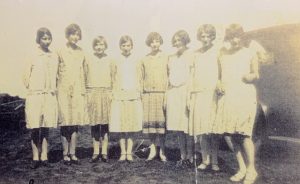
My job at home was to gather eggs and milk cows–usually the twins and I had that job. I started milking when I was six years old and milked cows until I got married. So, you see, I’m and old milk hand. We raised all our own potatoes which we always had to pick up and put in the large lumber wagon. We’d have several wagon loads. We never bought potatoes. We raised our own navy beans. Our mother sewed all out clothes. We usually had one good dress that we wore to church and Sunday school. We wore one dress to school a week, but we always changed clothers when we got home.
We lived three miles from our country school. I drove a horse on a buggy–her name was Molly. She was a white horse. I’ll never forget the day she died. I sat with her out in the barn–it was like losing one of the family. Then we had an old white team of horses which I drove on a sled. One day it was 3 below zero when I drove to school. It felt like my eyes had froze. I had a runaway once with them but it wasn’t that day. I also rode old Tom to school without a saddle–I can still feel the scars from that. Well, after Molly died, my dad decided I would drive another old horse. She was like a mule and she would chase you when you tried to catch her. I was sick about the whole ordeal that I was supposed to drive her on a buggy. Because I had driven her before and if she decided she didn’t want to go forward she’d back up all the time and cramp the wheels. My dad got the buggy all lined up and I was going to drive her–no way out. I said, “Dad, would you just please try her out first?” So he hitched her up. In his mind he thought I was crazy. He drove her to the mail box–she ran away with him. He got and she got him up against a fence. He got away and she smashed the new buggy and that horse ran away and we never seen her again. And that’s the best ending of the story that I can think of.
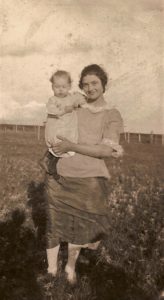
Back to my older sisters and brothers–Harold got married quite young so he wasn’t home long. He married out neighbor’s daughter, Lily Harms. They had one little girl named La Vonn Grace. She died of pneumonia at the age of three months. Ruth was our angel at home. She had to miss quite a lot of school to help with the home work. Ruth was almost like a mother to me. I was three years old when the twins were born’d. People just didn’t pay any attention to me after they came. I didn’t feel like I was loved anymore.
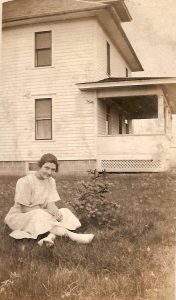
One day I walked up to Ruth and I was crying. I said to her, “Ruth, don’t you like me anymore?” She picked me up and kissed me and hugged me tight. She said she sure did love me, but I will never forget that day. She is truly a loving sister.
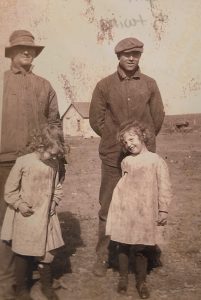
Harold was a great brother, also. Every winter we would be sick and quarantined with some disease. We had small pox, whooping cough, red measles and scarlet fever. Harold would come upstairs with oranges for the sick. We were feverish and didn’t get that many oranges either.
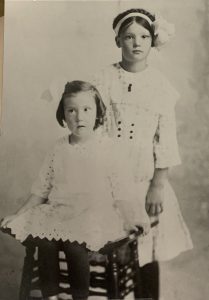
Merna is a great sister, too. She and I were close as there were only five years difference in our age. She, being the older of us two, we wasn’t suppose to race our horses, but like kids when we get our of sight we really raced them. We had a buckskin horse, real pigeon-toed–Merna was on that horse and I on Lauren’s pony.
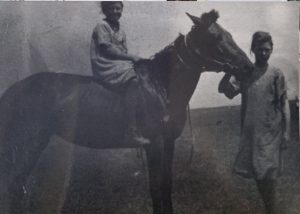
We got behind the hill and really let loose. Merna’s horse fell and I can still see her rolling. I thought she was dead, but she came out of it. I don’t think our folks ever found out about it , but we didn’t race again.
After Ruth got married, she married Elzo Sprang, we used to stay with them a lot. I’ll never forget the delicious lemon pie she baked.
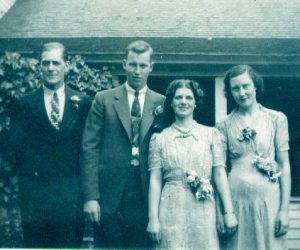
Lauren was a good-hearted brother. He always liked to sleep in the mornings. My mother said to get some water and get him up. So, I took a cup of water and poured some on his face. He came alive fast–he jumped out of bed and ran downstairs fast and around the house. He caught me and kicked me hard–not even like a horse. Anyway, I didn’t try that again. But, you know, he bought me all my wedding clothes and he cared for his sisters a lot–so much, when he took me along to a dance he made me dance with him and also eat lunch with him. But as you grow older you can understand his ways–it was a way of protection. It wasn’t because he enjoyed dancing with me or eating with me. He left home and started with a garage as a mechanic. Later he started working with Northwestern Public Service Co. Later, having a office of his own and a secretary, he married Edna Bronchaff and they had a boy Gerald who drown’d at age nine in Scatland, South Dakota. They divorced later.
We had a good time as we were growing up. We used to have dances at “big barns” with orchestra like, “Lawrence Welk,” “Tiny Little and His Toe Teasers,” and all those good bands. And oh how I loved to dance. And if you’ll pardon me for bragging a little, I was one of the best and I never sat one out. We did the “Black Bottom,” “Flea Hop,” “Charleston” and the bit. I still love to dance–music turns me on. How about that for a 63-year-old gal?
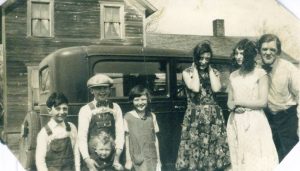
We had basket socials in our schools. They used to have rabbit hunts and sell the rabbits. Money would go to buy oysters and we’d all get together in the neighborhood for that. We had ball games at home. We had a team at home with all of us…and we’d play hide and go seek. On Saturday night we’d get out the old wash tub, heat water and have our shampoos and baths. On Sunday we would go to Sunday school and church. We had a Model T Ford and a big load of kids. Sometimes we’d have family picnics, but most times it was a day of rest for my folks because they wouldn’t work on Sunday.
On Christmas we had a big Christmas tree and the candles were little wax ones which were quite dangerous and were never kept lit for very long. We would have just one little gift. Mine was a glass doll–and a very small one. We would make clothes for it and were very happy to get it. Our mother would have such a nice Christmas dinner. Dad would kill the turkey and mom would dress it. Everything was done the hard way according to our everyday standards. Willard and Darrow, being the youngest really enjoyed Christmas. After Harold and Lauren left home, dad didn’t have anyone to help him in the field. Our mother would say, “I feel sorry for dad , why don’t you girls help him?” We would go out in the field and shock grain, plant corn, use the weeder in the corn, pick corn, and help haul hay. We did everything with horses. Dad would never let us use the field mower and things that was dangerous. He was a great man to work with. He’d never ask us to help him, but he was glad when we offered to do it. He was good-natured. We loved to work with him. He would tell us stories of his younger days and was kind and thoughtful–that the day was easy. He always had a twinkle in his eye and a big smile, but we really respected him.
Our mother was always nice to work with. She was a very patient mother. She was a beautiful seamstress. She had a shop of her own before she was married. She would get us to cut out a dress and everything had to be basted. Out of us 3 girls you’d never believe it, but in my sister’s eyes gained the most from it–oh, I cans sew up if there’s no problems. I remember once Ruth was going to make a pair of purple pants–they were the “in thing.” Purple, red, blue, she sewed them up backwards. I’ll never forget the laugh we all got from that. Ruth, being our oldest sister, didn’t appreciate those kind of laughs. One time I remember she had a date the night before–the next day she was tired. Us lazy twins and myself stood outside the kitchen window teasing her. All of a sudden the mop hit the floor, she came running after us. Boy, did we run. The twins got away and I would have but I stepped in a hole and fell. I hurt my foot a plenty, but my bottom hurt worse. I looked up from my hole in the ground for the twins–there they are up on the hill at our closest’s neighbor’s, Harm Harms and they were laughing so hard they were doubled up.
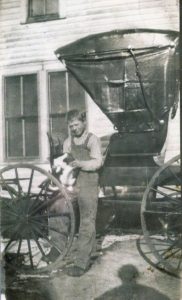
Almost everyone drove a horse and buggy for sometime, then came the Model T Ford. We had one at home and we really thought we had something great. But, at night when we got ready to go someplace, the light would burn out. They were the magnetic lights. Then we have to stay home. Usually, if we went someplace, it was to Bancroft. It was 5 miles away.
We were close, but we had our battles, too. We’d fix each other’s hair and we all had long hair and if all three didn’t turn out good, we’d mess each other’s up dragging one another around the room.
We had neighbors, the Ed Ritterbuchs, a brother of Fred who lives quite close we used to go visit them–they had a family of all boys. Their mother was a cripple and their father had to do all the house work and care for her. She was a cross old lady. Those kids didn’t get to be in the house. When they came in it was to the basement or to bed. We felt so sorry for them and mother always made us just sit when we went there. We girls thought how fortunate we were that we were blessed with our folks.
We used to have a nice pond in our hog lot and we spent a lot of time there in the winter time. We didn’t have skates, but skated with our boots. Then we had sleds and the Dakota winters were quite severe. We had big snow banks as high as our barn which we would slide off of.
I remember my mother losing some of her turkeys. She said to me, “If you find them I will give you some money.” I followed tracks which I thought were turkey tracks for miles and they ended up to be pheasant tracks. They were never found. I suppose some animal got them. We used to have coyotes on the west quarter. When we would to bed at night they would howl. Then the dog would cry in its way. We felt so secure in our upstairs bedroom. “The cry of the dog” we had always heard is a death in the family which worried us. Sometimes at night the dog would bark and carry on. There were chicken thieves around and also other animals. Our dad would get up and walk out there with his gun. We were all worried because we thought something would happen to dad.
Unless you lived on a farm in the horse and buggy stage you can’t appreciate it as a child. Our mother had a hand pull washing machine until later when we got one that’d run with an engine. Dad would have to be around when the wash day started. We heated our water in a copper boiler. We’d use lye to break the water. We’d let it come to the top and skim it off. It was an all day job, but we washed once a week and we had lines of clothes. People love them copper boilers, but I don’t care about those memories.
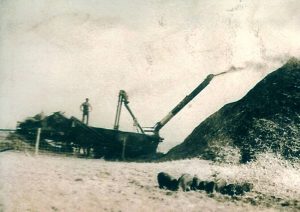
Also, the wooden barrel churn. It’s quite an attraction for the younger generation, but for me all I’d want it for is to sell it and make money. I used to sit down in our basement and churn for hours before we got butter. The “threshing rig” is an attraction for me because my dad had one. He threshed for other people, also. When I think of threshing time, and all those men to feed, I just can’t think our mother managed it. But, she was an excellent manager. We had to have lunch in the morning, dinner, lunch in the afternoon and they were big eaters.
There was hobos roaming around at that time. Dad would hire some for awhile, but our orders were to stay away from them. They slept in the barn. I remember one time we had one who was a snake charmer. He stuck a small snake in his pocket and it got lose in our house and nobody slept on the floor till it was found. Dad asked him to not bring anymore int to the house. We also had gypsies roaming around. You had to watch them if they came to your place they would steal everything they could haul. They came by horse and buggy.
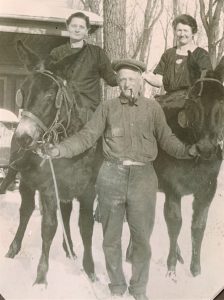
Hay time was a fun time. I’d go with my dad and help him haul in hay. It was put in the hay mow contraption with the horses. We used to have a lot of pretty horses. My dad had a livery barn in Stanhope, Iowa, and his horses was his pride and joy. They were decorated with pretty colored rings on the harness and other decorations.
One thing that always stayed with me–mom was making me a new dress. I kept after her to make it shorter. Finally, instead of hitting me over the head, with tears in her eyes, she made it that short. In fact, I felt a little conspicuous, but I wore it that way–it was nothing like the length of today’s dresses.
My mother made her own soap. I can still see her out there in the back yard doing it. She had a large black cast iron kettle. It had to be watched and stirred. When she baked bread we always had to go out and pick firewood and cobs. We girls would go out in the hog yard where dad fed the pigs, and pick up wagon loads, but we buried coal in our cook stove also. We used all pieces of wood and cobs when we had them. We had a kerosene stove which we used part time, but not too often.
Our kitchen had a long square table in it and when eleven people were at it, it was filled up. Our mother never asked us when we wanted to eat–she always had a nice plain meal for us. Our only worry was is there going to be enough–and there always was, but not much left over for scraps for the dog. Dish time was the twins and my job. One time I went into the barn and sat in the manger with the cats, but I didn’t work–dishes were waiting for me…. I also went to the outside biffy–Lauren came by and locked the door and I spent the afternoon there, but I can tell you there’s better places to spend an afternoon.
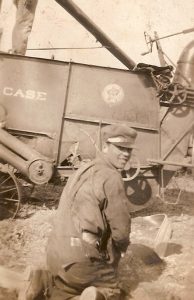
Our milk cows were very gentle except if Lauren would milk. If they’d swat flies and hit him he would beat them. We cold milk them anywhere. We always had to get them from the pasture. We had snake mounds out there and there was some wicked looking snakes laying on the mounds. We always wondered what kind they were. One time I saw one that had red horns.
My mother used to hatch her own chickens. We used to have several large incubators. It’s a great joy for a kid to handle a little yellow chicken. And her turkeys were usually hatched out under a hen. The first ones are so exciting to see. When we milked our cows there was always the separating of the milk. We kept our cream separator in our wash room. People love those old separators–but I remember all the times I had to wash it and that was an every day job.
We had a piano. Harold had a violin, Lauren a mandolin–we would all join in singing. Ruth and Merna played the piano. The twins and I also could play the piano.
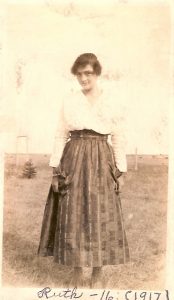
When Willard was a baby, my folks took a trip in the Model T Ford to Slayton, Minnesota to visit my mother’s brother and family, Uncle Jay and Aunt Zelma. We all stayed home. Ruth took care of Willard and when they got home, Willard didn’t even care for them. I have a card written to me from my mother while there. It is written in 1924. Not many of our relatives came to see us because they lived in Iowa and you just didn’t travel in those days. Uncle Will and Aunt Mattie and the family came the most and Grandma Kepler came occasionally, but Aunt Lizzie and Uncle Alf used to come from Iowa. In fact, Willard was named by Uncle Will and Aunt Mattie. My folks thought they had their family after Willard came, but when my mother was in her 40s Darrow came along. My dad, I think, wasn’t too happy about this and I remember he didn’t hardly look at him when he was born’d. But it wasn’t long he was the whole pride and joy of the family. We all baby’d him.
I didn’t mention that when Aunt Mattie and Uncle Will came from Iowa they always brought a carload of apples which made lots of canning, apple butter and jelly. We’d pick chokecherries at Spirit Lake and use the juice of them with apple juice which made delicious jelly.
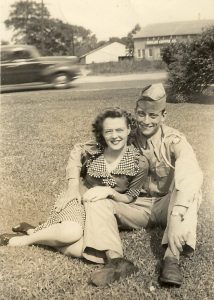
Willard and Darrow both graduated from Bancroft High School. I remember one time my dad took Darrow to Bancroft along with my brother-in-law Emmet Harty. Well, town kids thought country kids were hay seeds and these boys started picking on Darrow. He must have been around 8 years old. Well, you didn’t shove Darrow around… he got into a big fight, cleaned the boy’s clock, and the boy’s father was so mad that my brother-in-law and the kid’s dad almost had a fight. If it wouldn’t been for my dad they would have. One think in our family, if there was outside trouble, you’d have to fight us all. Because we were all for one and one for all. That was our motto.
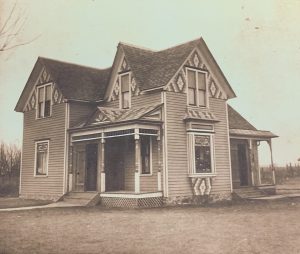
I forgot to mention that 9 of us were born’d at our home. In those days we didn’t go to the hospital. My folks lived in Stanhope, Iowa, where Harold, Ruth, Lauren, and Merna were born’d. My dad ran a livery stable there.
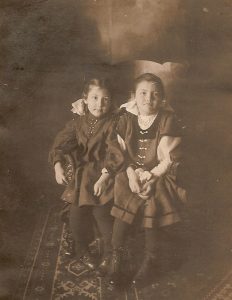
Then they moved to Boone, Iowa, where dad worked on the railroad. My mother wanted to get a job out of the city. She didn’t want to raise her family in town. My mother’s sister and brother-in-law were already living in South Dakota. This was Aunt Lizzie and Uncle Alf, so my folks moved to South Dakota. Then, later Aunt Lizzie and Uncle Alf moved back to Iowa. There was all dirt roads at that time. No gravel so when it rained we planned on getting stuck. If it rained any length of time, in those days, we always went barefooted. In the fall, when we started back to school, it was quite an ordeal to put them shoes on and keep them on.
I remember when I had my 9th birthday party. It was the only birthday party I ever had. It was a surprise. I was over at my sister’s house staying for awhile and I was to come home. When I got home my school friends were there to surprise me. It was a great day, but when lunchtime came around I had a mouth full of canker sores and I couldn’t eat lunch. But I enjoyed my school friends.
When we’d go out to recess at school the boys had mice and would stick them down our neck. So my girlfriend and I spent lots of our recesses in the biffy. One time we spent there, the bell rang and everybody went in the schoolhouse. My friend left the biffy but I hung back and sure enough they were still there and caught her and put mice down her back. One time when I went out to hitch our horse up to go home, two of those boys lassoed me and tied me to the telephone pole. They started up at the shoulders and all the way down. I stayed that way for awhile and then they let me loose. I’m telling you when I got home my mother got on the telephone to those boy’s parents and that didn’t happen again.
We used to play basketball at school. When I graduated from 8th grade I started high school in Bancroft, South Dakota. I had to work from my board and this lady wouldn’t let me play basketball because I was supposed to come home and work. I was so heartbroken over that. My girlfriends played. I finally lost interest in school. I went the first half of the year and quit. My folks brought me home. They said if I quit I was through. After a week at home I was ready to go back, but I didn’t like to say so. Many times I wished I hadn’t quit. The twins went to high school but they didn’t work for their board. Probably, my folks didn’t think that was a good idea since I quit. But they graduated from Bancroft High School. In those days they hated work worse than I did, they probably would’ve gotten fired. They’d come home weekends and they’d go to bed and sleep, discouraged because ma and I didn’t have all the work done. I should have mentioned this back further, but when we were going to country school I would get Molly all hitched up for school and I would sit outside waiting for the twins. One day I was quite unhappy about it all. I came in and Lucille didn’t even have her coat on. I gave her a shove and she fell over Willard’s baby bed and cut her chin. It bled a lot and she carries a scar. But Leona and I went to school and I felt just terrible I think it really hurt me more than it hurt her. But I never tired that again even if I felt like it. I always had to do the driving and they’d sit back all covered up in the buggy. Then, when we got to the school they’d run into the schoolhouse while I unhitched the horse. Oh, I guess that’s the penalty of being 3 years older.
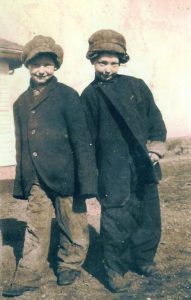
Lucille had another ordeal when my dad had the hay mow filled to the roof. She slid down and fell into the manger. She was in bad shape for awhile but snapped out of it, I guess we must have been tough to have survived all our ordeals. In the spring it was fun. We’d go out to gather wildflowers. The crocus was South Dakota’s wildflower, but we picked many kinds. There was many violets. We’d bring a bouquet to our mother. We gathered most of these from our pasture; the pasture whee our cattle was. We had a mean bull and one time he chased dad–he just made it to the fence. Dad had a black hat on that he hit him with in the eyes that stopped him long enough so dad got over the fence.
We used to have many storms in the summertime in South Dakota. Lightening would strike barns and other buildings. My dad got caught in one on the neighbor’s grade. We saw him on the grade, then we couldn’t see anything. He crawled on his hands and knees to the neighbor’s garage. We sure all worried about him.
I can remember Ruth before she got married. She had a date to go to a basket social. She asked dad if she could take a horse to go to Bancroft to get food for her basket. Dad wouldn’t let her and she got mad and she walked 5 miles to Bancroft. I don’t know why he wouldn’t let her take a horse, but I think the folks were more strict with the older ones. Anyway, she got sick and didn’t even go to the social. But that has always stayed with her.
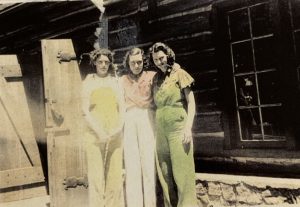
We just farmed a quarter at home, but when you do it with horses its not a fast job. But dad rented other land. Then Harold, Ruth, Lauren, and Merna were all married so dad had only the twins and I to help him because Willard and Darrow were too young. I remember dad and I picking corn on the west quarter, it was several miles away and snow on the ground. We did it all by hand. It was so cold. I was 17 years old. We walked by the wagon home. Dad put his sheepskin around me and I cried from the cold walking home.
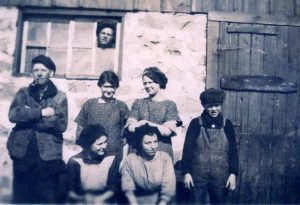
Herb–I knew him as a child. His sisters and my sisters were friends. They lived three miles from our farm. He would come with them and stand in the corner and smile at me. At that time I just hated him because I was bashful. We all went to church together–his sisters and mine.
Herb and I used to go to dances about 3 times a week. Most of them were barn dances, but they were nice big barns. We would also go to dances at the Spirit Lake Town Hall and also Bancroft Hall. We would go to shows in the theater. They were silent movies and they would have someone play the piano. The words were on the screen. We’d take rides on Sundays in his old Model T with a cloth top. One time the top was ripped and I was driving through Willow Lakes and Herb stuck his head through the hole. We’d drive to a lot of little towns in the area–Melham, Willow Lake, and De Smet. The first time I went to the fair in Huron was with Herb. My folks used to go occasionally. We’d take the twins along quite often to the dances.
Herb and I got married in 1930 just after the Depression began in South Dakota in 1929. That was a bad break for the folks like everyone else. My mother inherited some money from her folks–they bought a new car and put the rest in their land or farm. Then come the big Depression. You would put crops in and they would look good and then no rain. So we’d dry out. The grasshoppers would come in swarms and it would be almost dark when they passed the sun. They would land in the field and eat it up in no time. They would also strip our gardens. And we had real bad dust storms. My folks, like other farmers in South Dakota, got seed and feed loans. They did this year in and year out. This happened at least for 7 years. My folks didn’t have the place all paid for. They were like most South Dakota people. My mother said, “They’ll never take the place while I’m alive.” Dad would sit at night rubbing his head trying to figure a way out. But he wasn’t cranky or took his spite out on us. They finally got a government program started it was walled WPA. Everyone that could worked on it. It was planting trees, making dams and whatever needed to be done. Even our minister worked on it with my dad. We had enough to eat but that was about all.
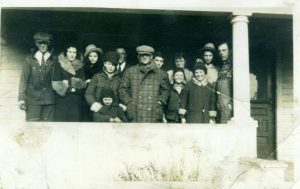
My folks had us all for Christmas dinner when Herb and I was living in Huron. Mom wrote us a letter and wanted us to come but she said there would be no gifts from them. She just didn’t have the money. I still have that letter. We all got together for Christmas. After Christmas she had a heart attack and died at age 54. It was such a shock to us all. She was only sick about a week. It was such a heart break because be all loved our mother so much. After my mother passed away, Leona, Willard, and Darrow were still home. Leona was with our mother when she had her heart attack. My dad was just lost after Mom’s death. Leona got married and he was left with Willard and Darrow. Darrow was ten years old and Willard a few years older. He tried to be a father and mother to Willard and Darrow but lived only a few years after our mother’s death. Not knowing he had lost the farm, he died at age 63. Darrow went to live with Harvey and Lucy for awhile then with Lauren in Wyoming. Willard stayed with Ruth and Elzo and us in Estherville. There was a farm sale which didn’t bring much because people didn’t have any money.
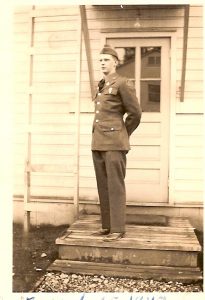
When Willard lived with us he spent time in the CCC camp in Bancroft, Iowa. He always had a fear it seems of war. He was 21 and the WWII broke out. He had to go to war. He trained in different states–California and Washington, and seemed to be okay. He was hurt on the head and had to be hospitalized. After recovering he came home on a furlough. We could see a change in him and he was real nervous. He should never had been sent across but they sent him. In Africa he was what they called “shell shock” and they sent him back to Springfield, Missouri, to a veteran’s hospital… Then we got him transferred to Fort Meade, South Dakota in the Black Hills area. He spent many years in these kind of hospitals. He later had some kind of brain operation to relieve pressure. He is now on a ranch in Deadwood area doing quite well considering the circumstances. But I hope there’s a better life for him in the here after then he’s had in this life. Darrow fought under General Patten’s–a tough army. He came back okay==very nervous. But he had a wife and little girl to come home to and things have turned out quite well for him and Betty in Rawlins, Wyoming.
Going back to grandparents, I never knew my Grandpa or Grandma Stemple and never saw them. They never came to visit in those days from Iowa to South Dakota a very long distance. My Grampa and Grandma Stemple talked only German. My Grandpa Kepler=I had never seen him, but after his death, Grandma Kepler came from Iowa to visit us. As a child seemed like a mean lady she was strict with us and made us go to bed early. But, as I got older, it must have been hard on her to stay at out place with all the kids. I guess that’s the generation gap.
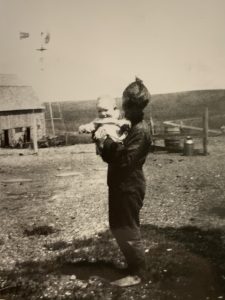
Herb and I got married when the Depression was on. We lived with Herb’s folks and Herb did the farming. Audrey was born’d in their home. In that time no one went to the hospital for baby cases. I remember Herb chopping wood for winter supply to keep us all warm. He had big wood piles. We had a lady who worked with Dr. Jameson and Mrs. Flint came when she was born’d. Then, after she was born’d my mother came and helped also. And with the help of Herb’s mother we got by okay. In them days you had to spend 10 days in bed after having a child and you were to lay still. Audrey had a hard time getting here and was finally taken with instruments. Her head was cut upon to the top of her eye and her skin was very dark. But her head healed real fast and her pink color came back fast. She grew and was a healthy baby. We all spoiled her.
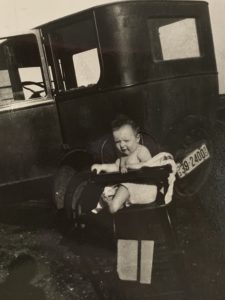
We left Herb’s folks and moved in with my folks. Dad seemed pretty happy to have someone to help him and Herb, being a good worker, was always right out there working. I was older and appreciated my folks by then so I tried to do all I could. But there was friction between the twins and myself. You just couldn’t buy a job–nobody had money it seemed. But Herb, being a good worker and doing everything he could to find a job–I had lots of faith in him. Finally he found a job with a fellow who was financially bad off also. Herb would work in the field with horses so thin and hungry they would fall down in the field. You’d go out to the hog houses and the pigs would practically eat you because of hunger. And his chickens were hungry and they wasn’t the only ones. I was nursing Audrey and all we had to eat was cold cereal, bread, sauce packets and water. We didn’t have potatoes or meat all summer. That was when I got down to 114 pounds.
I remember Herb, Audrey and I went to town (DeSmet)–I was so hungry I went to the bakery and got a little chocolate cake and we ate it before we got out of the car. In harvesting time, Herb, Otto Blote and Bill Anderson went to Aberdeen, South Dakota, to harvest crops. Bill Anderson’s wife, Evelyn, was a close friend of mine. We went to visit the men, Leona, and Evelyn, and Audrey and I. Leona and Evelyn had to find a sleeping place, but they had a place for Herb, Audrey, and I. Everybody babied Audrey and carried her around and loved her so much. One day she started to cry and we didn’t know what was wrong with her but we went to the cafe and all she wanted was mashed potatoes and vegetables. She really went for them and then she was okay. Those men thought she was great and wanted to carry her all the time, but her dad got first choice. And I at 114 pounds wasn’t able to carry her long.
Finally, when harvest was over–I guess I should mention this, Herb wanted me to buy a new pair of shoes. He gave me money but I wouldn’t spend it on shoes. I guess that is why shoes are my hobby today… After the harvest the men came back. The bachelor who we worked for was getting in worse shape. Finally, he just pulled out not paying us a cent. The chickens he said we could have. They were starving. Before I go on any further I should mention when the bachelor was gone Herb and I went to town and bought some steak and ate it all ourself. We hauled the chickens over to my folks. Then we came back to live with my folks again.
Finally, Herb decided to try the packing plant in Huron. He suggested the coal mines–I said absolutely no we’ll starve first. I wouldn’t let him go into the mines so he hopped a freight train and got into Huron. He slept at a police station. He gave me what little money he had if we needed something for Audrey. He had very little money along with him. He had a sister and brother-in-law in Huron, Minnie Sprang. He went to their place next morning and cleaned up and then went to the plant to see if he could get work. He finally got a job and that was a happy time for me. I thought we could move to Huron. He worked on the sheep kill which wasn’t much. He would come home to see us. Poor Audrey would cry and cry when he would leave. He’d finally sneak away. She’d go from one room to another, then she’d put hear head up against the door and cry her eyes out for her daddy. Then he quit in Huron and farmed Elzo Sprang’s quarter. The drought and grasshoppers cleaned it up, but he was called back tot he plant.
Finally, after he got some money saved he moved us to Huron. He found a house in the north part of Huron. A bachelor lived in it alone and he would rent it to us and keep one bedroom as he worked and didn’t get home until night. He was a great fellow with a big heart…Okay how was we to furnish it–mom says we could have the bed that was broke. We took it and wired it up. I had springs but no mattress. I don’t know why we didn’t have a straw mattress because that was what we had at home. She made me three quilts which we used for a mattress. Geraldine had a commode which Ruth let us use for Audrey’s cloths. Ruth also went down her basement and brought up canned goods, vegetables, fruit, and I’m sure they were canned meat.
Ruth and Elzo where also there when in need. They had a two-wheeled trailer. They said we could use it. We had an old Mocel A car so we took their commode, fruit, vegetables and trailer. Then we loaded up the bed springs, and whatever the folks gave us. Off to Huron we go happy as a lark and our little girl enjoyed it all. But every few miles we had to stop at a farm place and get water for the radiator. Good thing there was lots of farm places.
We finally arrived at our home–the first living by ourselves. Well, we didn’t have a cook stove kerosene so we went to a second hand store and rented one. Every time you would light it it would go up in sut. Finally, we bought a gas stove on time payments. The bachelor left a kitchen table we used. We managed somehow and was real happy.

But the first night we spent at that place we had a real bad storm. I guess I got ahead of myself–I forgot to mention when we got to Huron we had two flat tires on the trailer and two on the car and with the big storm we went to the basement. We sat there close together with Audrey on our lap covered with a blanket. It was so bad we were wondering if we’d survive. A window was out in the basement. Some big piece of tin or plank was coming through it. Those South Dakota storms were so severe those days but we was happy in our home. We didn’t have curtains for quite awhile because we couldn’t afford them but the first ones I got I paid 39 cents a pair. We didn’t have any rugs or linoleums either. We couldn’t afford electric lights so we used a kerosene lamp.
Finally, as Herb worked making 25 cents an hour, he was so tired when he got home he would fall asleep before I could get supper on the table. He would walk to the plant three miles the first year in Huron. Then, always he’d have to walk when it was cold because the old car wouldn’t start. I remember telling Herb I sure wished we could have electric lights and a pretty table lamp. But it was a yer before we had them turned on and it was probably six months or a year before we got curtains. We got by on $5 a week for groceries. I forgot to mention Herb, at this time, got on the beef kill working 10-11 hours a day. Herb worked quite steady until 1936 there was so much snow and they were only working 12 hours a week.
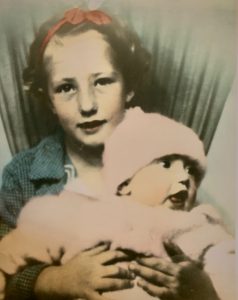
Then, in 1936, Shirley was born’d. It was a happy time. Audrey just loved her and we did too. Not all kids have a special order, but she did. Herb said after Audrey was born’d “Never again–never again.” It took 5 1/2 years to change his mind and he had a worse 9 months than I did. He built a beautiful birdhouse at that time… Some kids are jealous of their baby sister or brother, but Shirley was Audrey’s pride and joy. One time a friend came over with her little boy. It was warm so we had Shirley laying on the daybed in the living room. Gladys Churchill and I were looking at her and Winston walks up and slaps her face while she is sleeping. She woke up screaming, I could have spanked that kid till he would scream.
Herb just informed me that when they worked on the sheep kill they had to work fast as they could and didn’t even have time to go to the biffy. Herb said the men had it in for the boss so bad it wasn’t safe for him to go up town on Saturday night. I also forgot to mention in the little house in the north part of Huron, Harvey and Lucy spent their honeymoon with us. My mother sent food along or we couldn’t have fed them. The, the landlord offered his bed. He’d stay with friends. I put all clean bedding on the bed but there was bed bugs in his room and in his bed and they scratched all night, but we didn’t have any in our part of the house. Well, we moved away from that house to a cute little brown house in the south part of Huron on Symms Street. We still owed rent when we left the north home. By that time we had fairly good furniture, a mattress on our bed. We’re still using the bedroom set which we paid $25 in our last bedroom. It was an old set then. We had a day bed for davenport, we lived 2 1/2 years at each house and had electric lights, curtains and it looked quite nice to our standards.
Herb informed me in 1934 the Huron plant was closed so he worked in Austin, Minnesota and also in Sioux City. The plant was closed because they ran out of water. Herb, George Sprang, Sid Schaub and Glen Moore. In 1937 Herb got laid off and he and Frank Stienberg went to Saint Pail and worked a couple of months. They got laid off for three days. They were to be called back, there was a mix up and the telegram came a day late. Herb ran to the Toby brothers–they had been down to Estherville as a new plant had been built and they wanted experienced men. He decided to go along with the Tobys to Estherville along with Frank Steinberg and Roy Farrel. They were all hired. They were in Estherville three days before the plant opened. Herb sent a telegram home. He had got a job. We had relatives at our house that attended the state fair. They had supper with us. I was so happy I got supper on in no time. I thought that Herb was getting in on the beginning of the plant, he’d have a permanent job and we could have a permanent home. He worked here 3 or 4 weeks before we came. He rented an upstairs apartment at Cecil Erickson’s. Gladys Farrel was here and we came second then the Toby’s ladies and Nina Steinberg and family came last.
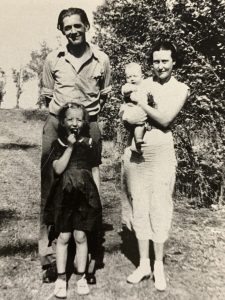 There is something I left out which is a little behind my story, but when Herb was in St. Paul he wrote us every day. I can remember just one day he didn’t write and it spoiled the day. It was so good to have Audrey and Shirley. Without them I wouldn’t have been able to make it. But we all slept together and on Wednesday night I would push the baby buggy with Shirley in it and Audrey walking alongside. We’d sit in the park and listen to the band play and we were quite a ways from uptown Huron. But I never forgot what a wonderful feeling I had and comfort from those girls. We would walk up town quite often. By this time we didn’t have a car. Herb had to borrow money on it and we couldn’t pay back. So, rather than lose it we paid the mortgage off.
There is something I left out which is a little behind my story, but when Herb was in St. Paul he wrote us every day. I can remember just one day he didn’t write and it spoiled the day. It was so good to have Audrey and Shirley. Without them I wouldn’t have been able to make it. But we all slept together and on Wednesday night I would push the baby buggy with Shirley in it and Audrey walking alongside. We’d sit in the park and listen to the band play and we were quite a ways from uptown Huron. But I never forgot what a wonderful feeling I had and comfort from those girls. We would walk up town quite often. By this time we didn’t have a car. Herb had to borrow money on it and we couldn’t pay back. So, rather than lose it we paid the mortgage off.
When we left Huron we stored our furniture at Leona’s on a farm and had it moved to Estherville when we could afford it. I’ll never forget the day we moved our furniture to Leona’s. Herb was in Esterville and I had all the work and business to take care of. We didn’t have a car so I hurried up town carrying Shirley. I tripped on the way home on a wire and knocked her out. I ran to a neighbor’s house and she called the doctor. He said keep her awake for half an hour then let her sleep. This I did and we had to ride in a truck to Leona’s staying there and at Ruth and Elzo’s before we moved down here. The girls and I rode to Eshterville with Allen Toby. The first night I didn’t hardly sleep all night as we stayed with Brown’s and I was afraid Shirley would have an accident in bed.
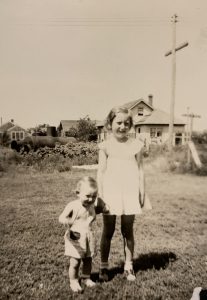
We moved to our furnished apartment. Audrey was unhappy there. She cried, Shirley cried, and I was so lonesome I sat down and cried , too. If someone would have come by and offered us a ride back to Huron I think I would have gone. We didn’t like an upstairs apartment and didn’t live there very long. Us and the Steinbergs rented a house together–each having an apartment. We wasn’t there very long and we moved to a house that had been papered and cleaned but there was bed bugs.
We didn’t stay there till the month’s rent was due. We heard about this cement house on S. 10th for rent. I pushed Shirley in the buggy and with Audrey walking we walked from the half mile hill to S. 10th Street and rented that house. It was a nice house. We had lots of lilac bushes and an apple orchard. I can’t remember how long we lived there. 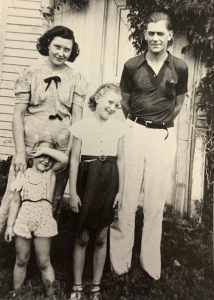 Then we rented a house on 3rd Ave. South until we bought the one where we are still living.
Then we rented a house on 3rd Ave. South until we bought the one where we are still living.
The Best of Times–By Shirley
I had always felt that I was born in the best of times. Audrey and I remark often to this day, how lucky we were. We always had what we needed and given lovingly by our wonderful parents. They were simpler times.
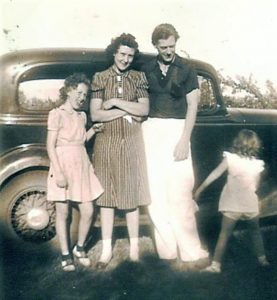 Saturday night downtown in Estherville was a big event. The important thing was to get a good parking spot. Dad would often take the car to town in the afternoon to secure a favorite spot. One that we’d be able to see people coming and going both ways. He would walk home. Then, the whole family would walk to town secure in the fact that we probably had the best people watching place on Main Street.
Saturday night downtown in Estherville was a big event. The important thing was to get a good parking spot. Dad would often take the car to town in the afternoon to secure a favorite spot. One that we’d be able to see people coming and going both ways. He would walk home. Then, the whole family would walk to town secure in the fact that we probably had the best people watching place on Main Street.
We girls would have so much money to spend. Probably a quarter. The best popcorn ever was first 5 cents and later 10 cents. The folks would do the shopping and then stop and visit at the other cars parked downtown. Then we’d sit in our car and others would come and stand by the window and visit with the folks. There were three “Dimestores” in town and each had a bulk candy counter full of good candy. Plus almost everything else you might need.
The kids would walk the streets back and forth. Girls would follow boys. I being so much younger, would follow my sister and her friends around. Don’t think she appreciated me hanging about. It was a simple but wonderful way to spend Saturday night. If I could bring that back I would. People just don’t know what they’re missing.
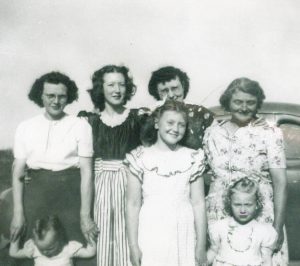 As a family I think we went to the movies every Friday night. We girls also managed to go any other time we could. We saw a lot of movies. I think I’ve seen all the old re-run movies on television when they first came out. When I started going, it only cost 10 cents; same with music. Mother loved music and dancing and must have played music on the radio all the time. I still remember words to the songs that were sung before I started school.
As a family I think we went to the movies every Friday night. We girls also managed to go any other time we could. We saw a lot of movies. I think I’ve seen all the old re-run movies on television when they first came out. When I started going, it only cost 10 cents; same with music. Mother loved music and dancing and must have played music on the radio all the time. I still remember words to the songs that were sung before I started school.
We first lived in an upstairs apartment when we finally got together as a family. Then we moved to a house on the half mile hill going into Estherville. As soon as the folks settle in–Trouble. Bedbugs were in the house and on the kids. Mother put me in the buggy and Audrey alongside and headed out to find another place to live. She found a place about as far as the other side of town as you could go, pushing a buggy with two kids. The place we left was torn down years ago and made a road leading to a new addition. Mom always referred to it as “Bedbug Hill.”
My first memory of living anywhere was this house waaaaay at the end of South 10th Street; great old house. Not the best location, but it was perfect for us. The local stockyards were close next door; also long gone many years. We lived there the years before I started school. Dad lied about my age and started me in school at the age of 4 almost 5. He said I was ready, but that’s another story. I have many good memories of a very young age.
Saturday mornings Dad would take me first to the stockyards to visit with whoever he was in charge. We always had to see what little animals were to be auctioned off. It was a huge old wooden building and it was very busy in its day. I think it burned to the ground years later. Behind our house was an apple orchard and behind that there were railroad tracks. We used to walk the tracks. He would put pennies on the track and next tie pick them up after the train had flattened them. We’d pick up big cinders from the trains and take them home and put iodine, Mercurochrome, salt and anything else you fancy over them. Then we’d watch the beautiful salt sculptures develop. I tried to copy that years later for my kids and never could.
This was a time when there were a lot of hobos; men riding the rails and traveling the country and looking for work. There were “bum camps” along the tracks–one not too far from our house. They would go to the houses by the track, knock on the door and ask if there’s anything they could do for a meal. WE had a lot of them knocking and mother would always feed them. It is said that if the hobos found a place that would give them a meal, they would make a marked somewhere for the next guy. I’m sure there was a mark somewhere by our mother’s door. She never forgot what it was to be hungry and she never turned anyone away.
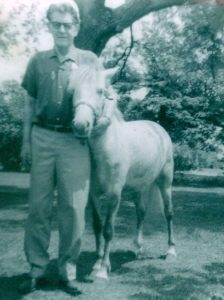 There was another packing plant alongside Tobins that was just as big and just as busy; Hills Packing Plant. They made dog food. Horses that had outlived their usefulness were sold to Hills. Also, wild horses were rounded up right off the open range and shipped to Hills. They kept them in big pens; lots and lots of horses. Dad and I would walk through those pens of wild-eyed horses cautiously when I got a little older. Mom wasn’t happy about that. On one of these trips he saw a horse he fancied and bought it. She was a beautiful race horse and we named her “Beauty.” She was also wild and temperamental so we didn’t have hr long. Then, he found another. Dad was a good judge of horse flesh and this one had been a pick-up pony in a rodeo for years–destined for the dog food factory and pop saved her.
There was another packing plant alongside Tobins that was just as big and just as busy; Hills Packing Plant. They made dog food. Horses that had outlived their usefulness were sold to Hills. Also, wild horses were rounded up right off the open range and shipped to Hills. They kept them in big pens; lots and lots of horses. Dad and I would walk through those pens of wild-eyed horses cautiously when I got a little older. Mom wasn’t happy about that. On one of these trips he saw a horse he fancied and bought it. She was a beautiful race horse and we named her “Beauty.” She was also wild and temperamental so we didn’t have hr long. Then, he found another. Dad was a good judge of horse flesh and this one had been a pick-up pony in a rodeo for years–destined for the dog food factory and pop saved her.
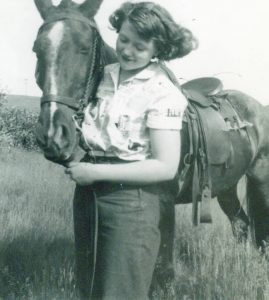 I lived in town and had a horse! How lucky can you get! Dad found a farmer who would keep her and he picked cockle-burs for her board. Mother grew up on a horse and liked to ride as well. Audrey wasn’t interested. I named her “Smokey” after a movie I had just seen. We could put 5 neighborhood kids on her at once and she would put up with us. But she could also run like the wind. She seemed to know who was on her and what was required. She was quite the lady. Even after we quit riding her we made sure she died of old age and never went to Hills.
I lived in town and had a horse! How lucky can you get! Dad found a farmer who would keep her and he picked cockle-burs for her board. Mother grew up on a horse and liked to ride as well. Audrey wasn’t interested. I named her “Smokey” after a movie I had just seen. We could put 5 neighborhood kids on her at once and she would put up with us. But she could also run like the wind. She seemed to know who was on her and what was required. She was quite the lady. Even after we quit riding her we made sure she died of old age and never went to Hills.
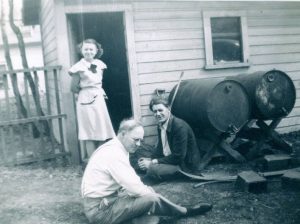 We also did a lot of fishing. Mostly bullheads were in the several lakes around Estherville. I write of early recollection and wonder, “Where was Audrey?” Well, that’s where the six years difference in age comes in. She was off doing things with her friends. Stockyards, tracks and horses were not to her liking at that time of her growing up years.
We also did a lot of fishing. Mostly bullheads were in the several lakes around Estherville. I write of early recollection and wonder, “Where was Audrey?” Well, that’s where the six years difference in age comes in. She was off doing things with her friends. Stockyards, tracks and horses were not to her liking at that time of her growing up years.
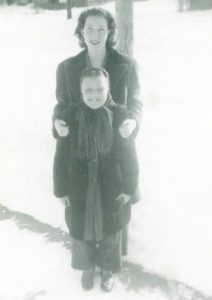 I do know that when I got a little older she got “stuck” with me a lot and I think I was difficult at times. I cramped her style often when she would have to take me along somewhere. I remember, at times, walking a half a block behind her and her friends. But she put up with me and was always kind. She’s still the kindest person I know. She got a job at the bakery early on in high school and later taught school. She liked clothes and bought a lot of them; much better dressed than I. I would sneak into her room and take her clothes to wear to school. She demanded that I stop doing that for years and I kept doing it for years.
I do know that when I got a little older she got “stuck” with me a lot and I think I was difficult at times. I cramped her style often when she would have to take me along somewhere. I remember, at times, walking a half a block behind her and her friends. But she put up with me and was always kind. She’s still the kindest person I know. She got a job at the bakery early on in high school and later taught school. She liked clothes and bought a lot of them; much better dressed than I. I would sneak into her room and take her clothes to wear to school. She demanded that I stop doing that for years and I kept doing it for years.
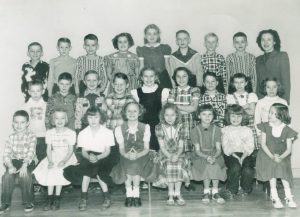 Dad thought she was too spendy on buying clothes. Mom said to let her go do it because the day will come when she wont be able to. So she did and she was one classy looking teacher-lady!
Dad thought she was too spendy on buying clothes. Mom said to let her go do it because the day will come when she wont be able to. So she did and she was one classy looking teacher-lady!
I did some babysitting growing up; a short stint in the detasseling field when I was just barely old enough to do it. They told me after two days I was too little to reach the corn and come back next year; so much for my first “real job.” I might add that I did go back year after year and continued even after my boys were little as the “straw boss.”
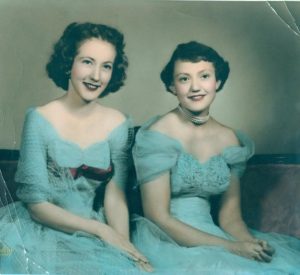 I worked at “Woolworths 5 and Dime” store in high school. I also worked at the local hangout for kids of all ages. I think mother figured out that I may as well get paid while I am here. It was right beside the schools and a perfect place for kids. The people that owned it made lots of money off pinball machines, juke box and cakes; best hamburger and fries I’ve ever tasted. The front step of that building was solid concrete and it sunk in the middle from so many feet wearing it down–really amazing! I would love to own that step today. The place was called “Makes” and it was packed most of the time. I even got engaged in the back room, but that was when I went to junior college.
I worked at “Woolworths 5 and Dime” store in high school. I also worked at the local hangout for kids of all ages. I think mother figured out that I may as well get paid while I am here. It was right beside the schools and a perfect place for kids. The people that owned it made lots of money off pinball machines, juke box and cakes; best hamburger and fries I’ve ever tasted. The front step of that building was solid concrete and it sunk in the middle from so many feet wearing it down–really amazing! I would love to own that step today. The place was called “Makes” and it was packed most of the time. I even got engaged in the back room, but that was when I went to junior college.
I loved high school and the friends I made. We never had competitive sports for girls in those days–just boys. The most fun I had was in plays and I got hooked in junior high when I was in “Tom Sawyer.” I had the lead in the junior class play, “Strictly Formal,” and in several other contest plays. I’m kinda proud that I went to State competition for One Act Plays. I received an “Outstanding Performance” award which, at that time, was pretty special. Not sure, but I think it still is. I have to mention it cause it may well be my only crowing achievement!
After graduating from high school I wasn’t ready to start junior college. Audrey finished junior college and continued her studies in summer school in Colorado while teaching school in Terril.
Some of my friends where heading to the big city and I didn’t want to be left behind; mother said that was a mistake. That if I didn’t go now I never would. In the end she must have grown tired of the argument and I won. I always joked that she had my bags packed and sitting by the front door six weeks before I graduated! I never said that I was smart! I planned to work a year and then go back to junior college. I was like most kids that are anxious to go off on their own.
Mom and Dad took me and my best friend, Lois Weber, and headed for the big city of Des Moines. We checked into the Elliot Hotel and set about finding us both jobs and a place to live; they stayed until we did. I found a job at Meredith Publishing Company in the advertising department. I worked on Successful Farming and Better Homes and Gardens magazines. Lois found a job at Capital City Bank. The folks found us a nice little upstairs one-room everything apartment with an old lady that reminded me of one of her sisters. That made her feel better, though we had doubts. Money was put in the bank for “in case,” and they left.
It was a fun year in Des Moines. Of course we moved right away to a bigger place and added two roommates. Always broke and borrowing from each other till payday–spending all my money on clothes. This was also in the day when you rode a bus to work; nobody had a car of their own. One of my roommates and I talked about joining the Waves. We talked and talked and then one day she came home and she did it. Whew! I worked my way up from clerk to being in charge of the advertising plates for the magazine each month plus proof reading the ads. Only mention that because I can’t believe it myself. Meredith Publishing is a BIG place with many employees. I liked my job but I did want to go to college. It was a good experience for me. I was more mature and got good grades when I did go back to school. Mother and I were both right–I did go back, but I only did one year and got married, never to return. It had been two years for a teacher’s certificate and then they changed it to four years. I might add that we went to Des Moines in 1953 and Lois ended up retiring from her job at Capital City Bank a zillion years later; figured she would have been running the place after all those years. Shirley Holmstrum–February, 2008
Kepler Descendants in America
From 1683 to 1820, emigrants left Germany and migrated to Southeastern Europe, North America, Russia, England, Scotland, and Ireland. This wave of emigration was caused by economic hardships and religious persecutions after the Thirty Years’ War. Many of these emigrants were Protestants from Southwestern Germany, primarily the Rheinland, Westfalen, Hessen, Baden, Württemberg, and Elsaß-Lothringen. (Family Search.org Germany Emigration and Immigration)
Benedict and Barbara Catherine Kepler, emigrated from Germany about 1720… One of the sons that made the voyage was Andreas. They arrived in New York—by 1734 were settled in Montgomery County, Pennsylvania… This is where Andreas Kepler II was born in 1746, and where in 1763 he married Margaretha Braun, whose parents had settled near the Kepler family. When the Revolutionary War broke out, John Kepler was only six months old… his maternal grandfather Nicholas Braun… uncles and cousins were soldiers. —Scott Eike–great-great grandson of Eliza Kepler (2)
John and Mary(Cramer) Kepler and Adam and Susannah (Beers) Marsh, had migrated to Ohio from Pennsylvania. Susannah sang at the funeral of President George Washington; Susannah’s father was a judge of the civil courts. The earlier immigrants of these families were Swiss and Franco German, English, and Scotch-Irish. As Protestants, some were German-reformed, some Quakers, and some Presbyterians, all had come to America to seek religious freedom. Bernice Christianson
Elizabeth Kramer, another daughter of the preceding Daniel Kramer, Sr., married Jacob Kepler, a third brother and a farmer near Pine Grove Mills, Pennsylvania. The abstract records of the Lutheran and Reformed congregations of Bush Valley, Centre County, Pennsylvania, dating back to July 9, 1792, listed the following husbands and wives among parishioners with the first year that they appear on the church records. Due to language barriers, illegible hand writing, and the low literacy rate in this historical period, many surnames appear in a variety of spellings. Present-day spellings of both English and German surnames were not standardized until late in the 19th century. This same German family appears not only as Kepler, but as Capler, Kepner, and probably several other spellings.
- Benedict Kepler (c. 1660-1735) m. Barbara Catherine in Germany. “Benedict Kepler was born 8, December 1660 in Klingenberg, Baden-Wurtteemberg, Germany, a state in southwest Germany, east of the Rhine, which forms the border with France. It is Germany’s third largest state. Benedict was a butcher and a judge in Klingenberg. He died after 1735 in New Hanover Township, Montgomery, Pennsylvania. (Pennsylvania-German Society)
- Andreas Kepler Sr. (c. 1700-1766). Andreas Kepler Sr. was born 30, September 1700 in Klingenberg, Baden-Wurttemberg, Germany. He was a butcher and an inn keeper in Germany. He died in Limerick Township, Montgomery County in 1766. His first wife Margaret Yoeger died and he married Catherine Hottenstien. (37; Pennsylvania-German Society)
- Andreas Kepler Jr. (c. 1746-1790) m. Margaretha Braun in 1763. (New Hanover Church Cemetery tombstone of Andreas Jr.)
- John Kepler (c. 10/09/1775-1833) m. Magdelena Kraemer in 1798 in Montgomery County, Pennsylvania. John was the second generation of his family to live in America. After marriage he moved to Lancaster County. He was the first of the family to settle in Ohio building a log cabin about 1811. John was elected Constable at the first election in Green Township. Although mostly a farmer, he did some blacksmith work. 22 years later he and his horse were instantly killed when a heavy cider press became detached and struck him. (11; Perrin)
- George Kepler (c. 1810-1844) died of typhoid. He m. 09/08/1831 Catherine Marsh (c. 1815-1844). George was born shortly after the move. Catherine died of typhoid at 28 years. Her parents, Adam III and Susana (Beers) had moved to Pennsylvania in 1819 settling near the Keplers. Her grandfathers, Adam Marsh Jr. and Capt. Enoch Beers, and great grandfather Adam Marsh Sr., all fought in the Revolutionary War.
- Alfred Kepler (c. 1838-1902) m. 03/13/1864 Eliza Ann Dirrim (c. 12/28/1840-03/31/1927).
The First Pioneers in Ohio
Ohio became a state in 1803 and the government offered cheap land for settling. Before the Ohio and Erie Canal was built, Ohio was a sparsely settled wilderness where travel was difficult. “John Kepler, blacksmith” came to Ohio with his family in the fall of 1809. John and Andrew Kepler, were among the first pioneers to purchase government land and establish permanent settlement in what is now Green Township, Summit County, Ohio.” (2; Perin).
Many years previous to the settlement in Ohio by the whites, Green Township was a favorite resort of the Indians. When the Kepler family first located in the township the Indians occupied several camps. At one was a chief called “Beaver Hat.” He was a bitter enemy of the whites, and when drunk he would take out a string with 13 white men’s tongues on it, dried, and exhibit and shake them with much pride. Understandably, this was the most upsetting to the whites. One day after doing this, John Kepler’s brother-in-law, George Harter took his rifle and started after him, saying he was going hunting. He didn’t bring back any game, nor was Beaver Hat ever heard from again. Scott Eike, great-grandson of Alta Mae (Kepler) Stemple (2)
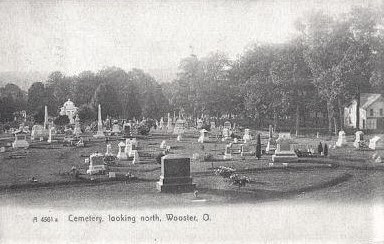
On a grassy triangle near the railroad trestle where Madison Avenue and South Beaver Street converge, a stone stands near the point where three Indian trails that crossed Ohio converged. The largest tribe in the Wooster area was the Delaware, also known as Lenni Lenape. The Delaware had been pushed westward across the Allegheny Mountains in 1768, making their settlements in Ohio. They stood with the British during the American Revolution. Although the government took possession of their lands on the Muskingum River in 1795 and removed them to Wabash County, Indiana, some individual groups remained behind. One such tribe was still living in Beaver Hat Town in the area that is now Wooster Cemetery when the first settlers began arriving. (13; The Daily Record)
The land the Wooster Cemetery is on once belonged to Delaware Indian Chief Beaver Hat who had his cabin and apple orchard there. The orchard was a gift from his friend, John Chapman, or Johnny Appleseed, who lived nearby. Beaver Hat’s Indian name was Paupeleman and his camp, or residence, was called by him Apple chauquekace–”Apple Orchard.” (14; Howe)
In the Cuyahoga Valley American Indians built small mounds rather than large ceremonial centers. After the annihilation of the Cat Nation of Eries by the Five Nations, the conquerors occupied Cuyahoga country under no pronounced geographic pattern. Small groups of the conquering tribes settled haggle-straggle up and down the valley. Small bands from other tribes westerning through found this river good and stopped to camp, then stayed. After the Erie’s last stand, the Indians of the Cuyahoga were migratory. One week you’d find certain clans up at the mouth, another week down at the head of the Tuscarawas.
The Kepler families moved to Green Township, Ohio, along with the Butchel and Kramer families. The Kepler brothers received one half section as tenants in common grant of President Madison on August 20th , 1810, which… their former residence was Centre County, Pennsylvania. (15; Meridith) John Kepler is listed as a blacksmith in Miles Township, Centre County, Pennsylvania, Assessment Book for 1803(2; Linn) and appears in 1800 federal census for the same township. John Kepler was appointed the first constable for the area (then part of Stark County) and his brother Andrew was first justice of the peace. (2; Perin)
The Kepler brothers had married twin daughters of Daniel Kramer, Sr. of Miles Township (later Haines Township) Centre County, Pennsylvania. John Kepler married Magdalena Kramer, and Andrew married Maria Kramer. The Kramers were formerly from Berks County, Pennsylvania, where they were prominent in social affairs. JoHann Daniel Kramer was a physician and surgeon. He immigrated with his family from Rommelshausen, Wurttemberg, Germany to Pennsylvania aboard the “Richard and Mary” on the 26th of September 1752. Settling in Berks County, the eldest son Phillip served as a Lieutenant of Berks County Militia and Sheriff. (17; Pennsylvanian-German Folklore Society) The Kepler wives are named in the last will and testament of Daniel Kramer Sr. of Centre County dated 20th of March 1813. (16; Bok).
The Kepler brothers were soon followed into the Summit County, Ohio, area by their sister Susanna Kepler and her husband Nicholas Sichley. (2; Perin). Elizabeth Kramer, another daughter of the preceding Daniel Kramer, Sr., married Jacob Kepler, a third brother and a farmer residing near Pine Grove Mills, Pennsylvania. (12; Montgomery)
Survival by Englishmen, Frenchmen, Indians, and Colonists on the Cuyahoga frontier had depended on hunting, trapping, growing corn, and procuring ammunition. Then, a rider arrived from Washington to announce the Republic had declared war on the King of England and the scattered handfuls of settlers along the Cuyahoga River had to decide what they were—British or American.
During the War of 1812, every able-bodied man was expected to turn out to protect the settlement from the Indians. John Kepler secured a man to go in his place, which was a common practice in those days. All that was necessary was to provide him with the necessary equipment consisting of a gun, knapsack and blanket. Before the war, Indians were peaceful in the township, but as they sided with the British they were compelled by the white settlers to leave. Scott Eike, grandson of Mildred Fransen
Whoever owned the Cuyahoga valley controlled the portage path, the driest and most direct path south to the head of the Tuscarawas on which men could float to the Ohio, thence to the Mississippi and the Gulf. Just south of the portage, moreover lay 64 small lakes for bass, pickerel, fowl, elk, and bison. When a few Jesuits came through their country the Eries refused their Christian religion, but learned some of their language. The English were fearful when the Eries held so aloof, preserving a strong nationalism. The British therefore distributed guns to their own allies, natural enemies of the Eries—the formidable Five Nations, the Upper New York State Indians: Mohawks, Oneidas, Onondagas, Cayugas, and Senecas.
While it is true that some of the first white men to reach Cuyahoga were peaceful missionaries and commercial fur traders, some whites going as far west as Cuyahoga were Indian hunters and scouts of changing allegiance. There was a type of frontiersman who served importantly in the development of the nation almost by accident. They served as scouts, runners, informers, and military officers, but their official status was generally vague. Some, like Revolutionary War Capt. Samuel Brady, could well have been motivated by personal or family injury from Indians; men who had suffered much from the Indians in a thin wave of pre-frontier exploration. Useful to the Republic, such men reported to Philadelphia. They reported the aggression and alliances of the English, French, Spanish, and other flags, but especially the Indians. (17; Ellis)
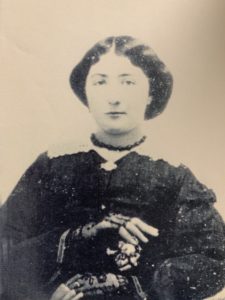
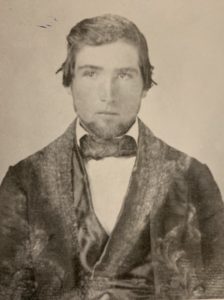
In 1835, George and Catherine Kepler left Green Township and moved to Coventry Township, Stark County, with their already growing family of three children. Fifteen years later, in 1844 they both would die of typhoid leaving their six children, ages 2-12, as orphans to be raised by different relatives.
George and Catherine (Marsh) Kepler, had died of typhoid fever in 1844 in Summit Co., Ohio. There passing at age 34 (father) and 30 (mother) left their children, the eldest 12 and the youngest 2 years, as orphans. There were four sons and two daughters. Mary Jeanette Anderson, Lizzie Kepler’s granddaughter
One of the orphans, Alfred Kepler, who was six when his parents passed away, was raised with his brother, Solomon, by their uncle Jacob Kepler. Jacob was a brother of the deceased father and his wife was sister of the deceased wife, too.
At age 21, Alfred married Susan Millinger and they moved to Steuben County, Indiana and lived there for four years. Shortly after being drafted into the war a member of the One Hundred and Twenty-ninth Ohio Infantry, his wife became ill. He returned home and then moved to DeKalb County, Indiana, where she died. Alfred married Eliza Dirrim on March 13, 1864, in Indiana.
The Early Settlers of Iowa
Adam Kepler was one of the early settlers of Hamilton County. In the spring of 1855, in company with his brother, Solomon, he left Summit County, Ohio, traveled to Dubuque, Iowa, and walked the remaining distance (191 miles) to Fort Dodge. He bought a section of land in Clear Lake Township, Hamilton Co., where he remained for one year before returning to Ohio. In April, 1858, after his marriage to Elizabeth Myers, he returned to his land on the east bank of the Boone River (west of the Saratoga Cemetery). Mary Jeanette Anderson, Lizzie Kepler’s granddaughter
After Adam settled permanently in Hamilton County, he became involved in many community activities. He and his brother, Alfred, who moved from Indiana in 1859, were among the founders of Stanhope and gave many substantial aid to the growth. Adam taught school in the winter when he was free from farm responsibilities. He organized the first Sunday School in Hamilton Township. Official positions held in the township were clerk, Assessor, and Justice of the Peace. Adam and his wife, Elizabeth, were the parents of 11 children. Six died in infancy and were buried near their home. The surviving children were William Lincoln, George Franklin, Otis Wesley, Cora Jane, and Emma Mae. Bernice Christenson
Adam and Solomon had taken their families to Hamilton County, Iowa, and Alfred and Eliza joined them in 1867. Stanhope, Hamilton County, Iowa, slowly developed. Most of the original town is actually the original Kepler farm. “Alfred Street” and “Kepler Street” are reminders of the family today and the library sits where the Kepler barn once stood. If you walk through Stanhope City Park you will find one-hundred-year-old trees that were planted by Alfred and Eliza.
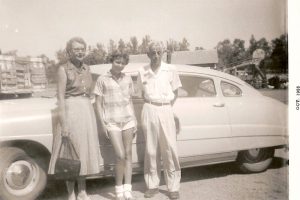
Dear Relatives, Sometime ago, our cousin Geraldine (Sprang) wrote to ask me some genealogy questions. I decided to go to my copy of “The Typhoid Tragedy” written by Jack Meredith, so that I would be accurate and to give some family backgrounds. Since my grandmother, Lizzie Anderson, was the youngest of the Kepler children, I included her remembrance as well as my mother, Beryl Anderson…. However, some were actually experiences as I visited the various relatives. My thought was to share this… Enjoy!! Your cousin, Mary Jeanette Anderson, Lizzie Kepler’s granddaughter
Dear Geraldine, 10/30/2007; Family History—Alfred Kepler (Alta & Lizzie’s father), his brothers and sisters, Susannah-12, Adam-10, Solomon-9, Mary-7, Alfred-4, William-2, were orphaned. Their father, George, died April 29, 1844 and mother, Catherine (Marsh) died July 27, 1844 of typhoid fever. Catherine had made arrangements with her parents and sisters to take care of the children. …sister took Mary, Alfred and William; Jacob Kepler took Adam and Solomon, and Adam Marsh took Suzanne. The George Kepler family lived in Summit County, Ohio.
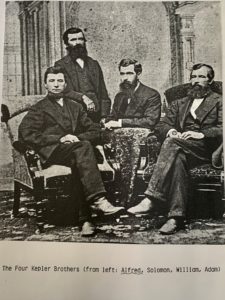
Solomon and Adam came to Iowa in the mid-spring of 1855. They purchased land in Clear Lake Township, Hamilton County, Iowa close to where the town of Stanhope now stands. They then returned to Ohio. Alfred and brother William served in the Civil War as privates. William was wounded on July 3, 1862. Mom said that Alfred received word that his first wife was ill and he returned to their home. Alfred hired a man to replace him in the war, which was legal at that time. Several weeks after his return, she died.
Alfred, Eliza (pregnant with Ida) and Isaac arrived by oxen drawn covered wagon from Indiana in October of 1868 and Ida was born a month later, around Stanhope, Iowa. Their (Alfred) family was located directly north of Stanhope and was 160 acres. In the middle of the town is a park which Alfred and Adam gave to the town. However, I don’t know what year it was. I do know that the park is fully utilized. Also, in Stanhope, there are two streets: Alfred Kepler Street and Adam Kepler Street.
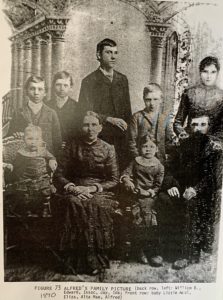 Alfred and Eliza Kepler Family: It is believed that Eliza had been married to a man by the name of Boar and possibly had a child. Nothing more is known. Alfred and Eliza were married on March 13, 1864. They lived near Hamilton, Indiana for four years. He went by “Alf” and Eliza by “Libbie.” They had 8 children:
Alfred and Eliza Kepler Family: It is believed that Eliza had been married to a man by the name of Boar and possibly had a child. Nothing more is known. Alfred and Eliza were married on March 13, 1864. They lived near Hamilton, Indiana for four years. He went by “Alf” and Eliza by “Libbie.” They had 8 children:
- Cyrus, 1865(died as an infant); b. Hamilton County, IN;
- Isaac, 1/26/1866,b. Hamilton County, IN;
- Ida, 11/20/1868-6/5/91, b. Stanhope, IA;
- Edward, 2/5/1870-1893, b. Stanhope, IA;
- William, 1/20/1872-1935, b. Stanhope, IA;
- Jay, 11/9/1875-1924, Stanhope, IA;
- Alta Mae, 5/4/1878-1/6/1933, b. Bancroft, SD.;
- Lizzie, 6/18/18832/11/1969, Tipton, IA.
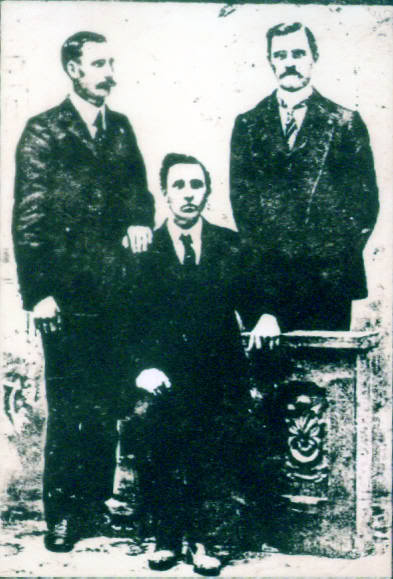
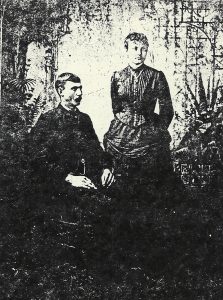
Isaac (Kepler)lost his left eye to scarlet fever. He always faced in pictures so that the left side was not visible. Mom told me that Isaac and Edward both had T.B. They went to Texas together for their health. However, it was too humid so they returned to Stanhope.
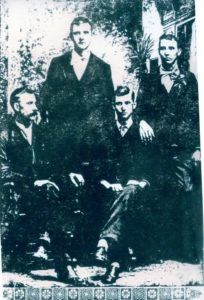
The very next day, after they arrived in Stanhope, Isaac left by train for Colorado. He settled in Delta, Colorado, on the northeast corner of town. He owned a big two-story house on the edge of town. I do not know when he bought it. Several weeks after Edward arrived in Stanhope he passed away. He was 22. This was 1893. Grandma Lizzie told mom that she remembered when her sister Ida died of T.B. The Methodist church’s bell tolled as she died. She was 23. This was 1892. Shortly before Ida died, she gave Grandma Lizzie a ring which she wore until the shank wore thin. Grandma would have been 9 years old. At the age of 10, Grandpa Alfred and Grandma Eliza and Grandma Lizzie moved to Delta, Colorado. They were fearful then because Lizzie was so tiny in stature that she might be the next to contract T.B. I don’t know how long they lived there or if any other of Lizzie’s siblings accompanied the three to Colorado. However, Mom told me that Grandma said as they approached Stanhope from Colorado, they stuck their heads out of the train window. They were so homesick for Stanhope.
Two years after Jay Kepler was born in Walnut Grove, Minnesota (11/9/1875), Laura Ingalls Wilder, 10 years old, arrived in town with her family. One year after Alta Mae Kepler was born in Bancroft, South Dakota, in 1879, the Ingalls family moved just 18 miles south of Bancroft to De Smet. Once married, Alta Mae would return to the area with her family. Years later, Alta Mae’s daughter Mildred would marry her neighbor and childhood friend Herb Fransen. Herb’s sisters, Sena and Minnie Fransen, helped the aging Caroline Ingalls in her home in De Smet. (5)
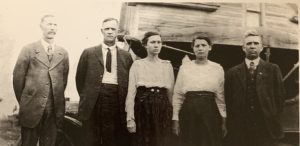
Isaac (Ike) Kepler m. Frances (Jones) on 3/12/1890. They had 6 children:
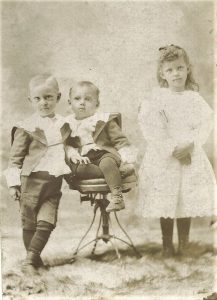
- Ernst m. Ana Roberts 3/8/1914;
- Ethel m. Henry Hutchinson 4/16/1911;
- Elmer m. Vera Boom 8/5/1929;
- Elsie m. Hayward Mums 9/12/1920;
- Glen m. Erma Larson 11/14/1923;
- Myrtle m. J.L. Lewis 2/10/1920.
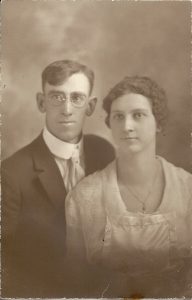
Ernst and Elmer ran a garage in Delta, Colorado. In 1949 we went to visit the cousin. We had car trouble… got to Delta over the new Million Dollar Highway—called that because because they used silver tailings to build the road. It took two days to get there… Ernst and Elmer fixed our car at their Buick garage….
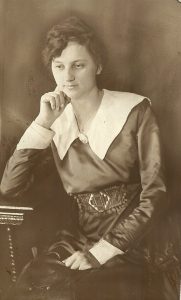
Mom always kept in touch with Elsie and I in turn kept in touch with her daughter, Francis Mae (named after her grandmother). I went to visit Francis when I lived in Durango. Before her retirement she worked as the comptroller for the Montrose School District… Francis had rheumatoid arthritis for years. She died August of 2005. She lived with her daughter in Fruita, Colorado… Glen worked for Los Alamos Laboratories. After Ike’s first wife, Francis, died, he married another lady. They bought a house in Delta. Ike and his first wife are buried on the west side of the cemetery in Delta. His second wife is buried on the east side. She felt bad that she could not be buried by Ike. The cemetery is located on a hill.
- William Kepler (c. 1/20/1872-1935) & 1. Ella (McFarland; c. 1875-1907), 2. Mattie (Johnson; c. 1877-1920). Children:1. Vernon m. Mable Dicks 1/15/1920; 2. Edgar m. Mable Johnson 6/27/1917;
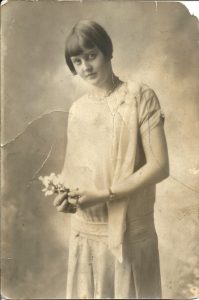
Erma Kepler 3. Erma m. Lewis Johnson 12/25/1919; 4. Lloyd m. Ida Hegg. Vernon and Mabel lived in Iowa Falls where he ran a grocery store. He was a successful man and his son was not. Mom and Dad always did family visits in Iowa Falls. Dad’s Aunt Vinnie (his mother’s sister) and her two children lived there. Edgar, Mabel, Erma, and Lou lived out in Hollywood. They lived on a dead end street kitty corner from each other. In February of 1947 we went to visit. Erma had just been diagnosed with leukemia… as we walked down the street someone tried to cut Mom and Erma’s shoulder strap purses. They cut them but didn’t get the purse. Since I had long hair, Erma heated an old-fashioned curling iron and curled my hair. We also visited Edgar and Mabel going there for supper. At 5 ½ , I could hardly wait to meet their daughter, Virginia… she was a movie star, she did bit parts but I thought she was beautiful… Erma died the summer of 1949. Her funeral was in Stanhope. Mom and Grandma Lizzie went. They stayed with Aunt Mattie. Edgar died in 1953 of a gunshot. Supposedly he had been cleaning his gun and it went off. He is buried in Forest Lawn I think. Lloyd and Ida lived in St. Paul. He was a navy man… In 1994, I took Mom to see Lloyd and Ida… it wasn’t too long afterwards Ida passed away and Lloyd died in the late 1990s…
-
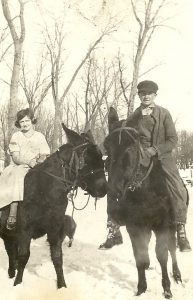
Farry Kepler Jay and Zelma (Mcfarland) m. 2/19/1902. I do not know if Ella, William’s first wife, and Zelma were sisters, but both were Mcfarlands. They had 7 children: 1. Leo m. Francis, 2. Keith m. Dolly Carter, 3. Farry m. Arnold Zienke, 4. Leila m. A. Zeinke, 5. Carrel Jay m. Dolly Carter, 6. Kenneth m. Dolly Carter after Carrel died. They had 4 children, 7. Vella and Ashton–I believe they are brothers but I do not know if they are twins.
- Alta Mae and Henry Stemple m. 2/10/1897. They had 9 children. 1. Harold m. Lily Harms 11/02/1919, 2. Ruth m. Elzo Sprang 11/03/1920; Lauren m. (1)Edna Brockoft 4/28/1931, (2) Beverly; Merna m. (1)Emmet Harty 10/14/1921, (2) Walter Sprang 6/03/1959. Walt and Elzo where brothers. Merna and Walt had dated before they married their first spouses; 5) Mildred m. Herb Fransen 2/14/1930; Lucile m. Harvey Marx 11/19/1932; 6) Leona m. Otto Blote 11/18/1933; 7) Willard; 8) Darrow m. Betty Moore 1/30 1942. m. 2/11/1903.
- Lizzie m. Olaf Anderson 2/11/1903. They had three children.
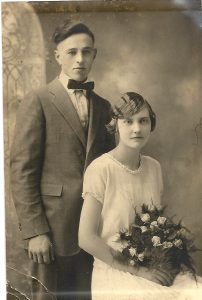
Beryl & Marvin 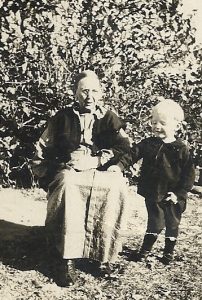
Grandma Eliza and Wayne Anderson 1) Beryl Madge m. Marvin L Anderson 9/10/1924, (2) Maurice B. Moffit 2/6/1962-4/28/98, 2) Irma Irene m. Genry Griton 2/15/1934, 3) Wayne Cecil m. Betty Lou Herbert 8/14/1944.
There is one thing I would like above everything else for my children, all ways be kind to one another, do unto others so you wish to be done by and try to live as Jesus would have us live. Lizzie Adel (Kepler) Anderson
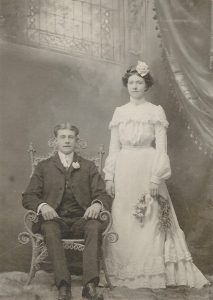
Lizzie Kepler and Olaf Anderson were married February 11, 1903. They were married at the Methodist Church in Stanhope with the reception directly across the street to the south. Mom always said the write up said the “Belle of Stanhope was married.” However, when I found the write-up it didn’t exactly say that but it was “flowery.”
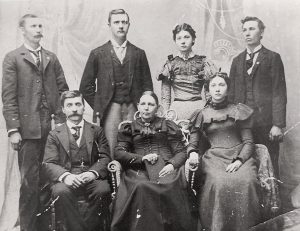
Also, along with this was a list of gifts given. Some gifts were a silver dollar. Grandma Eliza Kepler gave the couple a large square table which occupied them on their various moves throughout their married life. It now resides in the home of my great niece Melanie and her husband, Craig Sparby. Grandma Lizze made for her wedding reception 21 cakes. Now, whether they were white or angle food cakes, I do not know. One of those questions I forgot to ask my mother. Ollie was eight years older than his bride Lizzie.
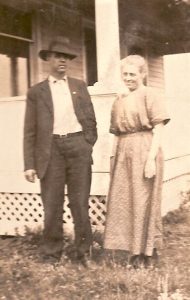
Aunt Mattie (2nd wife of William Kepler) was a wonderful little old lady and I loved her. When Paul was in college, Mom, Paul and I went up to Stanhope. We had gone to see Paul at Ames. If we got close to Stanhope, mom always wanted to go visit. This particular time we visited Aunt Mattie, Dehlia (1st cousin of Mom)…Aunt Mattie died the summer of 1957. Mom took Grandma Lizzie to her funeral, as Mattie would have been the last in-law. She is buried in Stanhope.
When Aunt Zelma died in 1915, she had 41 grandchildren and 67 great-grandchildren. She was 86. Mom told the story that when Grandma Lizzie would go to see her brother and Zelma, Mom went along. She would sit on the open stairwell with their children sitting around at her feet. As she would tell the story, it was so interesting that they would lean forward with mouth wide open and eyes big as silver dollars…
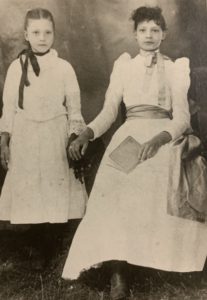
The sisters, Alta Mae and Lizzie and families always had Sunday dinner together.
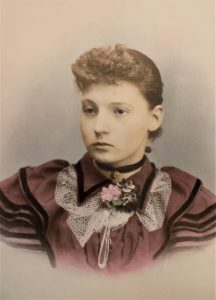
They took turns at being hostess… My grandfather, Ollie Anderson, had told Beryl that he remembered seeing Ruth when she was about 16, shoveling/unloading wheat at harvest time. He said she could unload/shovel wheat better than any man because she was so strong. Mary Jeanette Anderson. Lizzie Kepler’s granddaughter
When I was going through Mom’s things getting ready for the sale, I found a Daily Calendar Diary, 1934, book. As I looked through it I found several pages written in both Olaf and Lizzie Anderson’s hand. It was dated April 2, 1937. At that time Olaf was 62 years of age and Lizzie was 54 years. I personally thought it interesting on their approach to what should be included in their brief autobiographies: “C.O. Anderson born in Greenville, IL, 1875 moved to Iowa 5 miles east of Stratford on a farm my father bought paying $500 for 40 acres in 1882 lived their 1st April 1894 moving to Mt. Vernon, IA where my father built a house, went to school in Mt. Vernon 1 year and returned to Stanhope where I worked by the month on farms. In 1903 was married to Miss Lizzie Kepler–daughter of Alfred and Eliza Ann. I worked on county road 1st year and then rented 80 acres south of Stanhope next year Beryl was born…moved back to town and farmed Adam Kepler’s 2 years living with Lizzie’s mother had a sale last of Feb and moved to De Smet, So. Dakota in the spring of 1907 bought 160 acres that fall 35 an acre took pssess–in March 1908 had three good crops dried out about 1/2 crop 1910. Erma was born July 1st -1910. 1911 was a total failure had one wagon of barley off 200 acres. Bought 80 acres adjoining in 1909 traded for 120 acres where we still reside in Lisbon, Iowa. [Traded March 1st in 1912] Then moved to Nordland farm in De Smet S.D. had two good crops there then had $2730 sale and moved March 1st, 1914 to Lisbon, Iowa–took twelve years to pay for this farm so it was 1926 when we got it paid for lots of saving and we were happy when it was paid for. Bought Dugan farm in fall of 1935 took possession March 1936 that is Erma did. We pay 5 pecent on Dugan farm and 6 percent on our farm south of Lisbon. Written by Olaf Anderson “from South Dakota, De Smet came to Iowa 1914 paid $6000 debt on farm, got it paid for 1926. Bought Dugan farm 1936 paid for it by 1942 $6,300 for it.”
April 2, 1937, Lizzie Anderson was born. Lizzie Kepler in 1883 in Stanhope, Iowa, Hamilton, Co. Lived in Stanhope until the spring of 1907. Was married to Olaf Anderson in February 11–1903. In 1907 moved to De Smet South Dakota lived there seven years on farms, then moved to Lisbon in 1914 on own farm of 120 acres 3 children were born to Lizzie and Olaf. Beryl Madge August 22 1904, Erma Irene July 1st 1910, Wayne Cecil February 15 1922. Grandchildren Paul Dean September 5 1928, Joan Beryl January 16 1935, Mary Jeanette March 24 1941.
Grandma Lizzie’s father died when she was 19. She and her siblings inherited 2/3rds of the estate because there was not a will. She was an estate businesswoman. She had a checking account long before it was “fashionable” for women to do so. She also had hens and always sold the extra eggs. Even in her late 70s, she still had some hens for her daily usage. If she loaned money, she expected it to be paid back, even if Grandpa Ollie borrowed it.
Grandpa Ollie was an industrious man going to work when he was 11, but waiting to marry at the age of 28. The day he married he had $5 in his pocket, which doesn’t sound like much now days, but in 1903 prices it was probably a good sum. He had given Lizzie a beautiful ring. It has three oval, fire opals that are approximately the same size. Sitting on either side of the middle opal is two small diamonds.
I do not know how Grandpa Ollie found the first farm 51/5 miles north and west of De Smet, S.D. I would assume through a land speculation. He shipped his livestock and farming equipment via the railroad which had a depot in De Smet. The depot currently has been turned into a wonderful mission. The next morning, Ollie went out to the Ban farm which he had rented. However, much to his surprise, the lady of the house had just delivered a baby the night before–therefore putting on hold their move to Montana. Grandpa then rented the farm directly to the west of the Ban farm.
When the Andersons moved to Ban farm, the house had two large rooms, one upstairs with a stairwell to it and a large room downstairs with a front porch attached. At one point a kind neighbor had 1/2 a load of coal which was delivered and put on the front porch. Grandma was disgusted! Little did she realize that a ground blizzard could come up in an instant and people could get lost going from home to out buildings.
Eventually Grandpa had the house built onto, roughly when Mom was 4 1/2. One day Mom was outside carefully walking on the 2x4s the carpenters had laid… One of the carpenters got tired of the “chatter” and said “children should be seen and not heard!” Mom left, highly “insulted.” In 1994, Lucille and Howey took Mom and myself on a drive–we stopped at the Ban farm currently owned by Les Ban and his wife. Lucille explained who we were and could we come in. As we sat there having coffee and cookies in the big kitchen, Mom vividly recounted exactly where Grandma had everything placed. As we toured the house, Mom “vividly” recalled the night her sister Erma was born in the downstairs bedroom. She often said Grandpa couldn’t wait to show her new baby sister. He woke Mom up to show her the baby. Mom’s reply at six was, “is is a doll?” That was July 1, 1910. As we went upstairs, I couldn’t help but notice how the steps were worn. We stood in the small east room where Mom had once slept and looked out the window at the South Dakota landscape. Grandpa later built a hip-roof barn northeast of the house.
My Grandfather always signed his name C.O. Anderson. You see, in South Dakota there were a lot of Olaf Andersons. He liked the name Chauncey so in order not to get his mail mixed up with other Andersons he went by C.O. ever after. Grandpa and Grandma shopped at Lofter’s Store (of Little House on the Prairie fame), as did everyone else. One day when Grandpa went to town for supplies around Christmastime, he was told to get Mom a coat, which he did. Much to Grandma’s disgust, he purchased a red and black plaid mackinaw.
“4th of July morning! 4th of July morning!” was the cry heard across the South Dakota prairie. It was Ollie Anderson’s favorite holiday and he could be heard yelling that the evening before. “The 10th of June” when the Andersons lived in South Dakota was a big deal in De Smet with activities, a carnival and good food with lots of visiting with their neighbors; now its called “Old Settler’s Day.” On one of those days, Mom came up to Grandpa Ollie (her father) and said, “Papa can I have another nickel to ride the carousel?” He just reached in his pocket for the nickel, as he threw his head back and laughed. This gesture he was famous for. Mary Jeanette Anderson
I also remember one time when we were going to a celebration that was a big deal for us, all the little towns had them, but this was “Old Settler Day” at De Smet. We got ready to go and Merna pushes me off the porch and I got a real bad nose bleed. They couldn’t hardly get it stopped. Anyway, it ended up we all stayed home. Always at these celebrations they had foot races. I could run like a deer. I was tall and skinny. You wouldn’t believe it by looking at me now. But I would enter the races and usually always come out first, once in awhile, second. The twins were on the sidelines cheering for me because I usually divided up the $2.50 with them and it was our money for the celebration. Mildred (Stemple) Fransen, daughter of Alta Mae Kepler
One day on the Ban place, Grandpa loose-tied his horses (team) with its wagon bed of hogs to the porch post. Inside the house, Grandma told Beryl to go outside and shake the husks out of a sack. So, she did–scarring the horses as they ran away with Grandpa in pursuit. The wagon ran over his foot breaking his toe, but he did stop the horses. Grandpa told Beryl one day to go out to the pasture and get the cows. So she did, however, out in the prairie pasture were some beautiful wildflowers. Of course Mom had to pick them. Never mind that there were storm clouds “brewing.” Pretty soon there came her father with his rain slicker on. He got to his daughter just in time, turning his back to the storm. He wrapped Beryl in his slicker and they stood there with the rain coming down, but she was sheltered by her father and his slicker. After the storm subsided, father, daughter, and the cows walked back to the barn.
When they lived in the Nordlund farm–it sat high upon the hill. Spirit Lake was to the south and was on the edge of the farm. The Andersons would go fishing on this lake. Mom just loved going out the see the lake as it brought back so many fond memories. I was lucky to be able to go and see this lovely house when I was 18 and Geraldine and Les Hubbena (Ruth Stemple and Sprang’s daughter) lived there.
After the Andersons moved to the Norland farm in March of 1912 it was time to enroll Beryl in her new school. The one room school sits on the east edge of the Nordland farm. It is now used as a townhall. Grandpa saddled up the horse and put Beryl behind him and went to school. Mom said as Papa rode the horse by the west side of the building, she looked down through the windows and saw the students there. Across the road from the schoolhouse to the east was a farmstead with a grove of trees. Mr. and Mrs. Nutt lived there. They raised coonhounds. One day she climbed on top of the mailbox and sat there. Pretty soon a man in a wagon came driving along and just looked at her sitting there. Mom always wondered, “wouldn’t you think he would have stopped to see why I was sitting on top of the mailbox?” Of course pups being pups they had already left–leaving Mom still perched there and scared. Mary Jeanette Anderson, Lizzie Kepler’s granddaughter
After the Andersons moved to Lisbon, Iowa in 1914, Grandma Lizzie would send several bushels of apples each fall to the Stemples because fruit was not plentiful in South Dakota. Even after the move back to Iowa, Ruth and Beryl remained close exchanging letters as well as phone calls in later years. Their communication always just as they had recently seen each other. Beryl went to South Dakota every chance she’d get, Ruth and Elzo came to Lisbon to see Lizzie and Ollie and all of the cousins in the early 50s.
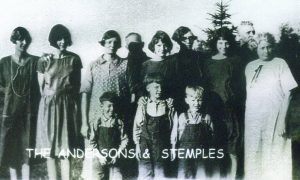 My mother and father went to South Dakota see Ruth, Elzo, and Geraldine the fall Ruth was pregnant. Ruth liked my father, Marvin, very much. She thought Beryl’s husband was very nice and good looking. She honored my father by naming her son Marvin. Mom, when talking about that visit, would say, “I just wanted that baby to be born so bad while we were there, but he wouldn’t be born.”
My mother and father went to South Dakota see Ruth, Elzo, and Geraldine the fall Ruth was pregnant. Ruth liked my father, Marvin, very much. She thought Beryl’s husband was very nice and good looking. She honored my father by naming her son Marvin. Mom, when talking about that visit, would say, “I just wanted that baby to be born so bad while we were there, but he wouldn’t be born.”
When we would visit in later years, Lucille and Mom would somehow get around to discussing Grandma Eliza Kepler’s disposition. Lucille would say she was mean and grumpy; Mom would say she was gentle and kind. Mom theorized that when Grandma Kepler lived with Lizzie and Ollie every summer it was quiet (relatively) at the Anderson’s. While, when she visited the Stemple’s there was always a lot of noise because there were so many children close to each other in age. Of course Lucille and Leona always loved a good time and if one got their hair fixed better than the other one the twin without the nice hair-do got taken down and her hair messed up. Mom contended that Grandma Kepler liked her “peace and quiet.”
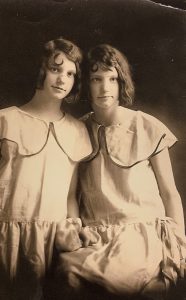
Lucile and Leona always liked to walk side by side. Beryl might start walking between Lucille and Leona, but gradually she would find herself walking on the outside. Mary Jeanette Anderson, Lizzie Kepler’s granddaughter
My mother and Aunt Minnie both got teacher’s certificates from General Beadle Collage in Madison and taught county school before they married. Mom taught at one close to home so she stayed there and made a little money teaching and bought a piano. During that time their home caught fire. They went in the house and the piano was right inside the door so it was one of the few things they got out. I don’t remember mom ever playing it, but she still had it when she moved to town. The house grandpa built was eventually moved to DeSmet and is still occupied. So, you can see Grandpa had some hard knocks…. One time Grandpa took my mom to the school where she was teaching and the horses ran and tipped the buggy over and she was under the buggy. I wish I’d known Grandma better. She died on a hot summer day. There was a bad car accident right outside their driveway. She was too heavy and excited by the accident that she had a heart attack and died that day. She was only 62! Caryl Lynn and I saw where she was baptized when we were in Holland six years ago at Nieuw Beerta near Groningen, Netherlands. Calvin Poppin
Stemple Family Descendants
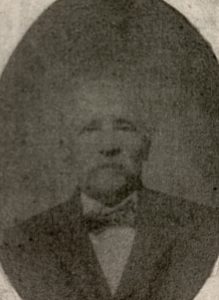
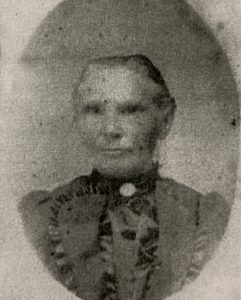
Maria Frings married Gerhart Stemple in 1861. They lived in Erkelenz, Germany for three years, and then came to America in 1864. They came to New York, then Ohio, and later Chicago.
In 1876 they came to Iowa and located on a farm south and east of Stanhope. In 1890, they moved to Stanhope. Gerhart was a coppersmith and he also owned a hardware store in Stanhope.
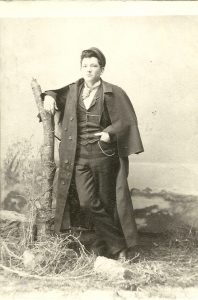
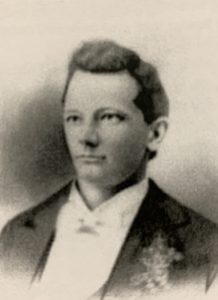
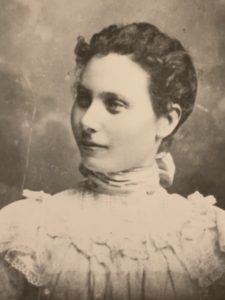
Henry Stemple, son of Gerhart and Maria, married Alta Mae Kepler in 1897. When a fire destroyed much of Stanhope, in 1905, Henry and Alta Mae, along with Alta Mae’s sister and family moved to Bancroft, Kingsbury County, South Dakota.
Henry and Alta Mae were running a livery barn in Iowa when her sister and husband, the Olaf Andersons, found a farm for them to rent.
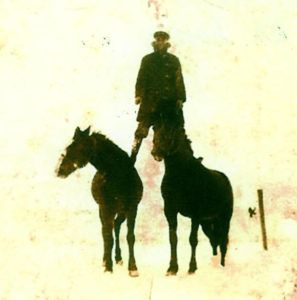
They took their four children (at that time), Harold, Ruth, Lauren, and Merna to South Dakota on a train in 1908, bringing a carload of big work horses with them.
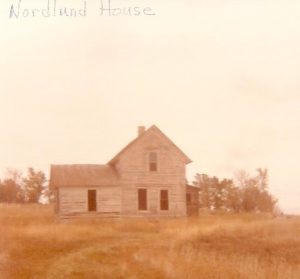
They moved to Reynold Norlund’s farm west of Spirit Lake. They went to church at the Basart School where the Rev. J.E. Booth was minister and later they went to the Bancroft Presbyterian Church.
Henry and Alta Mae Stemple had 9 children:
- Harold Glen b. 8/13/1898, Bancroft, SD; he m. Lily Harms 11/2/1910.
- Ruth Gwendolyn b. 1/16/1901, Bancroft, SD; she m. Elzo Sprang. She d. 6/10/2004, De Smet, SD.
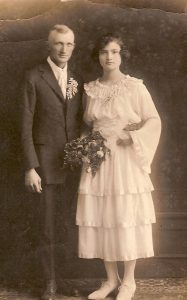
Elzo & Ruth - Lauren Gerald b. 6/9/1904; he m. Edna Brockoft 4/28/1931; Beverly (2).
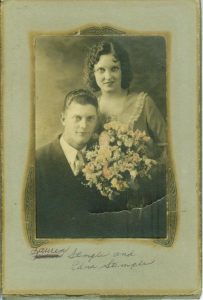
Lauren & Edna - Merna Gladys b. 7/23/1906, Bancroft, SD; she m. Emmet Harty 10/14/1921; Walter Sprang (2).
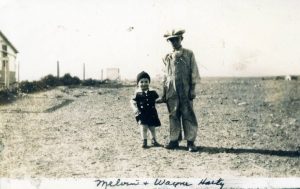
Melvin & Wayne Harty. 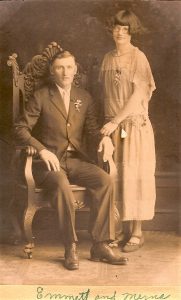
Emmett & Merna - Mildred Gertrude b. 4/1/1911, Bancroft, SD, d. 5/17/2000; she m. Herbert M. Fransen (b. 3/9/1905, d. 6/8/1975) 2/14/1930.
- Twins Leona Fay and Lucille Fern b. 5/24/1914; Lucille m. Harvey Marx 11/19/1932 and Leona m. Otto Blote 11/18.1933.
- Willard Attie b. 7/12/1919, Bancroft, SD.
- Darrow Wesley b. 6/4/1922, Bancroft, SD; he m. Betty Moore 6/30/1942.
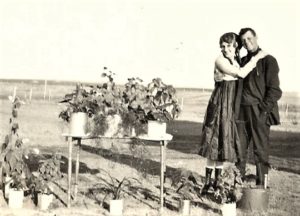
When Harold got married to Lily Harms, our closest neighbor, we were all sick with small pox. My mother, dad, and most of us kids.
I remember looking out the window and seeing all of those cars over there. As Harold was getting married in Harm’s home he was coming down with small pox. He had to sit down when he was being married and he crawled in bed with his blue serge suit on.
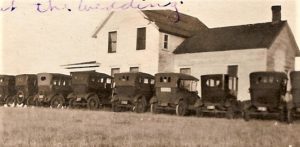
I don’t know how we all survived. Elzo looked after us and brought our groceries and done chores. He was a good man. There was a fellow who felt sorry for us and he said he would bring food from the wedding. I don’t know what for because no one could eat, but he just brought it—stuck his head in the door. Mildred , daughter of Alta Mae and Henry Stemple
Fransen Family Descendants
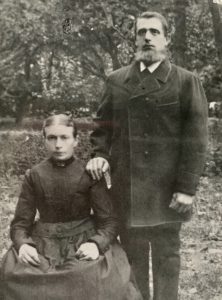
In 1890, Theus Arends Fransen and Truda (Smid) Fransen emigrated from the Netherlands.
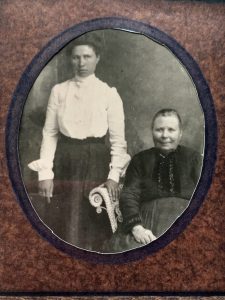
Ten years later Theus’ parents, Arend and Geeske came to the United States from Beerta, Groningen, Netherlands.
According to Darrell Fransen’s genealogy (42), economic realities were not the only reasons for the influx of the Dutch people to America. Because the church form of government in the Netherlands was corrupt in the first half of the century, Christians were dissatisfied with unbiblical practices that had crept into the church doctrine and worship. Emigration reached its peak in the later half of the century as Dutch agricultural communities settled in Kansas, Nebraska, North and South Dakota, Minnesota, and later into Illinois, Wisconsin, Iowa and Michigan.
Arend Fransen (11/18/1838-2/20/1904) b. in Nieuw Beerta, Groningen, Netherlands and d. in Ackley, IA m. Geeske Thijes Ruiter (9/23/1832-10/29/1916) b. in Bunde, Germany and d. in Grant Twp., IA.
- Jan (John) Arends (1863-1966).
- Geesjien (Grace) Arends (1866- ) m. Snattter.
- Theus Arends (1868-1941) m. Truda Smid (1870-1938) 12/30/1896.
- Reinder (Reinner or Ray; 1871-1934) m. Kate Ebbenga ( -1931) 8/19/1905.
- Hiltke (Helen; 1877- ).
Harbert Jans Smid (4/30/1840-2/1922) b. in Nieuw Beerta, Grongingen, Netherlands m. Geessien Jans Jansen (8/19/1843-1909) b. in Jieuwerschans) 8/15/1889. Geessein Jans Jansen and Harbert Jans Smid had 10 children.
John Jan Harbert 10/19/1864-3/19/1871 b. in Nieuw Beerta, Groningen, Netherlands; d. abt.. 6yrs. old in Holland.
- Klaus Harbers Smid 4/30/1866-3/25/1905 b. in Nieuw Beerta, Groningen, Netherlands, d. in Lake Preston, SD; m. Theresa Siebrands.
- Henry Harbors Smid 2/12/1868-1915 b. in Nieuw Beerta, Groningen, Netherlands, d. in Lake Preston, SD; m. Grace Bogue.
- Gertrude (Truda) 5/12/1870-9/16/1938 b. in Nieuw Beerta, Groningen, Netherlands, d. Lake Preston, SD; m. Theus Fransen 12/30/1896.
- Annie (Antje) 7/19/1872-1962 in New Beerta, Groningen, Netherlands, d. DeSmet, SD; m. William Janssen.
- John Harbers Smid 4/7/1874-2/5/1853 b. in Nieuw Beerta Groningen, Netherlands, d. Lake Preston, SD; m. Catherine Johns (1) 1/10/1912; Bena Buss(2).
- Sena (Geesien) 7/29/1875-9/16/1938 b. in Nieuw Beerta, Groningen, Netherlands, d. ND; m. George Aven.
- Harmen Smith 12/16/1879-1/1959 b. in Nieuw Beerta, Groningen, Netherlands, d. in Lake Preston, SD; m. Kate Johnson 3/7/1906.
- Aaltje (Alice) 1/21/1886-8/4/1953; d. in Lake Preston, SD, m. Simon Bogue.
- Minnie Harmke 8/4/1888-1945 ; d. in Lake Preston, SD.
Herbert, Grace, Arend, Minnie. Sena, Theus, Gertrude, Anna.
Theus Arends and Truda (Smid) Fransen had 7 children:
- Grace 12/29/1897-1981 m. Fred Ritterbusch 10/15/1887-1980. They had three children: La Vina, Amy, and Glen Fred.
- Sena 6/23/1899-1995 m. Otto H. Poppen 1922-? 6/23/1920.
- Arend 2/8/1901-3/23/1964 m. Minnie Irene Gear 3/26/1924. They had 5 children: Darrell, Dorothy, Frank, Raymond, and Harlan.
- Minnie 2/12/1902-5/26/1986 m. George Sprang 3/26/1924. They had three children: Wendall, Carol, and Marilyn.
- Anna (8/6/1903-1988) m. Leslie Lyle (1901-1978) 1/30/1929 . They had 2 sons: James and Don.
- Herbert 3/9/1905-1975 m. Mildred Stemple 2/14/1930. They had two children: Audrey and Shirley.
- Theodore 12/19/1911-3/12/1912 who died at 3 months.
Minnie Irene Gear married Arend Fransen on March 26, 1924. Arend, born February 8, 1901, in Sibley, IA, came to Potter County with his parents Theus and Gertrude Fransen from DeSmet in March 1919, with his two sisters, Minnie and Anna, and brother Herbert. Sisters Grace and Sena remained in DeSmet.
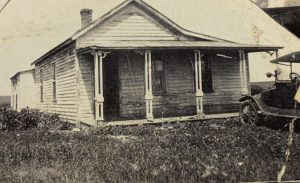
The Fransens settled on a farm a mile east north of Gettysburg (north of highway 212 across from drive-in theater).
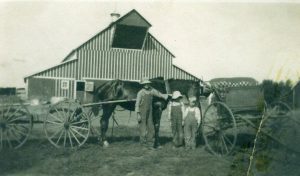
Five years later the family all returned to DeSmet except Arend who, recently married, stayed on his father’s place to continue farming.
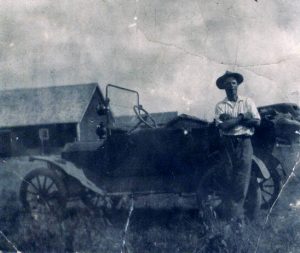
Arend’s sister, Minnie Fransen and George Sprang of DeSmet were married in a double wedding with Arend Fransen and Minnie Gear at the Methodist parsonage at 209 W. Garfield in Gettysburg. Minnie (Fransen) Sprang had taught at North Cunningham School the previous two years. Some of her pupils, as near as she can recall, were Elise Larson, LeNora Erna, Ewald and Elvera Breitkreutz, Lyle Thompson and a younger brother, Tillie and John Gross, Marie, Arthur and Eva Hagan, Raymond and Darrell Schekel, and Ervin Killian.
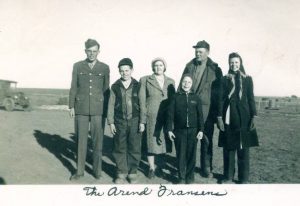 Arend and Minnie Fransen had 5 children: Darrell, Dorothy, Frank, Raymond, and Harlan. They farmed east of Gettysburg at five different farms including the Fransen place, Bartles, Lee, Simon and Medbery places until Arend died May 23, 1964. Frank Fransen
Arend and Minnie Fransen had 5 children: Darrell, Dorothy, Frank, Raymond, and Harlan. They farmed east of Gettysburg at five different farms including the Fransen place, Bartles, Lee, Simon and Medbery places until Arend died May 23, 1964. Frank Fransen
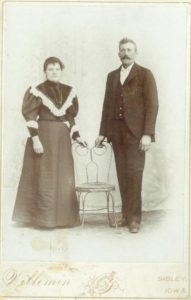
Grandpa (Theus Fransen) first proposed at Spirit Lake even though it was a hilly, stoney, farm and he had trouble keeping water on his farm—had trouble finding a good well. He borrowed money on his farm at Spirit Lake and bought a farm in Gettysburg. He rented it out to a farmer who, my dad said, stole so much that it wasn’t profitable and the hard times of the 30s had just set in. Then, the drought and the dust storms hit. By this time he was too old to start farming again as he had lost two farms. He was somewhat bitter at Herbert Hoover. Caryl Lynn Poppen
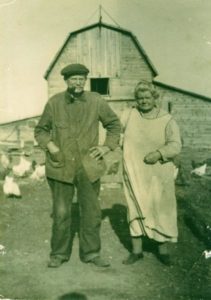
Theus Arends Fransen and Truda (Smid) Fransen emigrated from the Netherlands. Ten years later Theus’ parents, Arend and Geeske came to the United States from Beerta, Groningen, Netherlands. Economic realities were not the only reasons for the influx of the Dutch people to America. Because the church form of government in in the Netherlands was corrupt in the first half of the century, Christians were dissatisfied with unbiblical practices that had crept into the church doctrine and worship. Emigration reached its peak in the later half of the century as Dutch and agricultural communities settled Kansas, Nebraska, North and South Dakota, Minnesota, and later into Illinois, Wisconsin, Iowa and Michigan. Darrell Fransen
Gertrude Patterson’s Notes: Gertrude Patterson was a first cousin to Herbert Fransen and at one time was his teacher. She did much research over the years including hiring a genealogist in Holland to help her: They crossed the border first because they wanted to get away from the Catholic prince of Germany. They preferred the Dutch Calvert Republic. The church was and still is a part of the government. Another reason why they crossed over into the Netherlands was to escape poverty at home and earn a decent wage in wealthy Holland. The German people were poor compared to the Dutch at the time. In those days, the German people did not call themselves the “master race.” Those that crossed over were grateful for a modest wage and were easily absorbed by the Dutch people who gave them employment. They spoke Low German, similar to Low Dutch, and adjusted easily. In this way, our family became Hollanders.
Right here you will note that by the records we have that they were both in Germany. Their father’s first name was with and “s” added and became their last names. Also note that after 1801 surnames appeared. Napoleon conquered the country in 1795 and lost it in 1813. He had conquered Russia as well and started to march to the Kremlin with a million men. The Russians cunningly retreated and when the army got to the Kremlin, not a bit of food or shelter was left. The Russians had destroyed it all. Napoleon’s army started back in the Russian long winter with neither food, clothing or provisions. On the long frozen trek, only a few hundred men survived. He took 15,000 of Holland’s fine young men and only 300 returned. This gave the Dutch people a hatred for war and the immigration to America inviting as there was no compulsory military draft in America for quite a number of years. In my father’s time (Klaas Smid), it was done by conscription. It was done by lottery. Uncle Henry drew a blank.
My father was born with an eye that was deficient. The rest of the uncles were eager to escape to America–economic reasons were the principal reasons. Too many workers for too few jobs, causing too low wages. I asked my Uncle Herman one time who my Dad (Klaas), came to America with. He said he came with a pal Ben Elsing, who he thought still lived in Comfrey, MN.
I went to see Mr. Elsing and he was delighted to see me. I asked him to tell the whole story: “A bunch of us young people spending on the Hoorn. Then Klaas called him aside and said, ‘I have a good notion to go to America.’ To this Mr. Elsing replied, ‘If you go I’ll go with you but I hate to tell my folks.’ Both boys had girlfriends and were eager to marry but wages wouldn’t warrant starting a family. It was arranged to see his family the next afternoon. When Klaas came through the gate, Ben’s mother said, ‘Here comes Klaas, I wonder what he wants.’ Then Ben told them what they were there for. She started to cry. All afternoon they talked pro and con. Shall we go or shall we stay. Finally, Ben’s father spoke up and said, ‘You boys go. There is 25 for every job here. If you don’t like it, we’ll do our best to bring you back.’ They went to my mother’s brother (Gertrude’s) Peter in America.” He had gone several years before. When asked if he got work he said he got work right away. He said they came and got us the next day. He said they got BIG wages and laughed. When I asked him how much he answered $17.00/month. He thought that was good because they had board, room, and washing and it would be more than $170.00 today. No gas to buy. All they needed was tobacco money. My dad got a job with a big cattle feeder. His place had a second house, so he sent for my mother. Mother came in June and it only cost $40.00 to come. Mother’s father and mother had died and mother inherited a little money. She had enough to bring my Dad’s father, mother and the rest over the next spring. Ben Elsing worked three years and then went over and brought his girlfriend and his family over. They settled in Freeport, IL. That’s were I was born. I have a picture of the house.
My father and Ben came to America on the ship “Westerland”? They sailed March 21, 1889, and arrived in Freeport, IL, on April 7, 1889. Gertrude’s mother’s brothers Peter and Will had come a few years before. They stayed at Peter’s the first night of their arrival. The Dutch people who emigrated wanted to get away from no jobs and a poor economy and conscription into the military which was required. Families saved and brought the rest of their families to America, which is still being done today.
Gerhart Stemple was born November 11, 1836 in Reisch (Race) Germany. He died in Stanhope, IA, July 5, 1913 at the age of 77 years. He had a brother and a sister that we know of. His parents were said to be Reichstag which means parliament or something to do with the government or something of that nature. They died and Gerhart was raised by the uncle.
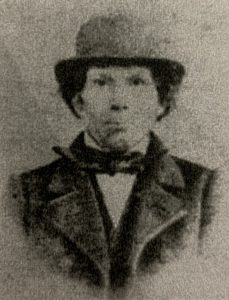
He ended up in Erklentz, Germany, working in a factory owned by Peter Heinrich Frings. He ended up marrying the boss’s daughter, Maria, in 1861. They lived in Erklentz for three years and he worked as a coppersmith. They must have had some means because of their backgrounds. Maria’s family was quite musical and played numerous instruments and were involved with various bands. We know that Maria had a brother, Franz, and that there father was married for a second time and that he had other children. We don’t know why Gerhart and Maria came to America, but he came first in 1866 and then went back for Maria and their two children Johanna and John Gerhart, in 1867. They first arrived in New York were Gerhart was employed as a coppersmith and brass worker. After several years they moved to Stryker, OH, where Harry, Mary, and Willie were born. Willie died in infancy in Ohio. After Stryker, they moved to Chicago and in 1876 located on a farm southwest of Stanhope, IA. They later moved to town.
Once established in their new home they didn’t care to go back to the old world. They came with their Dutch Bible and Dutch language and soon after changed to English. English was the predominant language and the only one taught in the American schools. Even names took an English aspect. My father’s surname was Smid after Napoleon conquered the Low Countries and ordered surnames for everyone. In the records that are recorded in the townhall in Beerta it was often spelled Smit or Smid, but on my father’s citizenship papers it is spelled Smith.
Excerpt from Phientje Van der Wunirt DeFriesluter, Gertrude’s pen friend in Amsterdam: “You asked me when people got their surnames and this is quite a whole story. In 1785 came an end to the Republic of United Netherlands. The chief of the managing committee was William V. He was Prince of Orange and and ancestor of Queen Julianna. The Republic of France had declared war on all the princes and monarchs of Europe, including our Stadholder William V.. The French army had conquered the Republic of the United Netherlands. Prince William V. escaped with his family to England. A new republic was built. The Bataafoche Republic. The emperor Napoleon had the power in France and in 1806 made his brother King of Holland.
In 1801 there was the beginning of a new constitution and the Registrar’s Office, by order of the end of the power of Napoleon, continued to exist. This is a brief survey of the coming into existence of our surnames.
Dear Shirley [Fransen], … Grandpa Theus Fransen had the reputation of being somewhat of a “character.” He had to do all his farm work with horses and they were sort of a rat tag bunch. One day when he was in the fields one horse was lagging, not pulling its load. Grandpa threw a rock at the lazy horse and hit a good horse. He said, “Excuse me, I meant to hit the lazy one.”
Grandpa came from Holland with his folks. His father got so lonesome for the old country he became dispirited and committed suicide. I didn’t remember Grandpa being difficult; he just did things in a strange way. When he wanted to see his mother he told his family he was leaving and didn’t say when he’d be home. He’d walk to DeSmet, take the train to his mother’s in Iowa, and sometime later he’d just show up in the morning having walked all night. On one of these walks he found a cap on the road so he picked it up and wore it. He later had lice in his beautiful curly hair. He was rather athletic and quite agile. I remember him wearing overalls, etc…, and never remember seeing him dressed up.
…I can remember the folks going over to visit and Grandma had a little hammer and a little saw she let me play with. One time when we were there Grandma choked on a piece of meat. Your dad and my dad beat her on the back and took her outside on the cold porch so she could get some air. I was so scared she would die. Somehow they got her breathing again. After they moved to a little house in DeSmet. (I think her brother Herman helped them buy it.) It was on highway 14.
Grandpa had to have a prostate operation. My dad and uncle, Fred Ritterbusch, took him to Sioux City. He was all alone and had none of his family to support him. I felt bad about that. After Grandma died, Grandpa would stay with the Ritterbusches, the Lyles, at our place, etc. He Pronounced my name “Culvin” instead of “Calvin”. He always smoked a pipe.
Grandpa had a brother, Reinder, who lived in Bryant, South Dakota, married Kate Ebbengo who died early. They had a son, Frank, who became a vagabond. Sometimes he’d be gone for a long time. Delbert and Charles were other sons and they had daughters: Clara, Vera, and Florence. Charles and his wife in Hessington Springs, South Dakota. He was a jeweler.
Grandpa had a sister who married Henry Schnoer. They visited a few times. He was a little man. Always happy! He’d come about harvest time after his wife died. He helped mom as much as he could. He was drafted when he was young and also served a rich boy’s draft.
I remember your dad and was rather awed by his strength and confidence. When he brought your mother–I think to live with his folks–I thought your mother was pretty. I liked it when she paid attention to me!
My mother and Aunt Minnie both got teacher’s certificates from General Beadle College in Madison and taught county school before they married. Mom taught one close to home so she stayed there and made a little money teaching and bought a piano. During that time their home caught fire. They went in the house and the piano was right inside the door so it was one of the few things they got out. I don’t remember mom ever playing it, but she still had it when she moved to town. The house Grandpa built was eventually moved to DeSmet and is still occupied. So, you can see Grandpa ha some hard knocks.
One time Grandpa took my mom to the school where she was teaching and the horses ran and tipped the buggy over and she was under the buggy. I wish I’d known Grandma better. She died on a hot summer day. There was a bad car accident right outside their driveway. She was too heavy and excited by the accident that she had a heart attack and died that day. She was only 62! Caryl Lynn and I saw where she was baptized when we were in Holland 6 years ago at Nieuw Beerta near Groningen, Netherlands.
I’m going to copy what Cal said and send one to each family… do you have Richard Fransen’s book, “The Fransen Family”? Your Cousin-in-law! Caryl Lynn Poppen (Sena Fransen m. Otto Poppen, Otto Poppen’s brother m. Caryl Lynn)
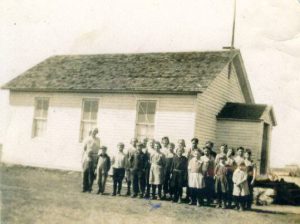 Harold and Ruth attended Prairie Hill School the first year and after that all went to Shady Lawn School. They lived on the farm seven years, acquiring a quarter of land on which they erected buildings and dug a well. They enjoyed this new home. DeSmet Centenial, “Yesterday & Today” by Caryl Lynn [Meyer] Poppen
Harold and Ruth attended Prairie Hill School the first year and after that all went to Shady Lawn School. They lived on the farm seven years, acquiring a quarter of land on which they erected buildings and dug a well. They enjoyed this new home. DeSmet Centenial, “Yesterday & Today” by Caryl Lynn [Meyer] Poppen
Mrs Otto [Sena Fransen] Poppen writes about the family, “My mother, Gertrude Smith[Smid], and her sister Annie worked as hired girls. Annie worked for the Pommers, great-grandparents to Keven Pommer and Mrs. Wendel Schubloom, both of DeSmet. Gertrude was a pastry cook at a Sibley, Iowa hotel. She married Theus Fransen in 1896. My father’s brother, Reiner Fransen, moved Bryant and his children include: Clara Vaughan, Mildred Hall, Charles (m. Arlene Rexted) and Delber (m. Helen Garrey). My Father, Theus Fransen, bought a farm northwest of DeSmet where Kenneth Pirlet now lives, and Grace and Sena started school at the Bowes School with Frances Paterson as the teacher. They later traded the farm for one in Spirit Lake Township, where we children attended the Prairie Hill School. Minnie and I graduated from Madison State Normal School. My parents are buried in the Lake Preston Cemetery. DeSmet Centenial, “Yesterday & Today” by Caryl Lynn Meyer Poppen
The Kelley School was built in the 1800s and was considered the center of entertainment. Children would come and play games there and even Christmas potluck dinners. When the Kelley School was too old and too small it was replaced by the new Prairie Hill School in 1920. After Prairie Hill eventually closed Sherman Williams bought it and it is still on his farm. De Smet Centennial, “Yesterday & Today” by Caryl Lynn Meyer Poppen
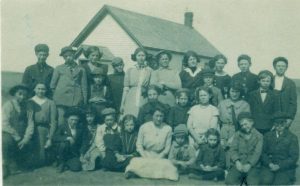
When Minnie Fransen (Mrs. George Sprang) started to school she had to sit on a recitation bench, her legs tiring quickly because her feet didn’t touch the floor. She was the youngest of 42 pupils, and there just weren’t enough desks to go around! Slates and slate pencils were used in school work. The slate pencils were about seven inches long and broke easily. The pupils cleaned their slates with a damp cloth. Some of the teachers at the Prairie Hill School were Della Whiting, Ida Anderson, May Greenaman, Anna Kelly, Olivia Knudson, Gertrude Smith, and Nellie Squires. De Smet Centennial “Yesterday & Toady” by Caryl Lynn Meyey Poppen, p. 292-293
Native American Spirituality
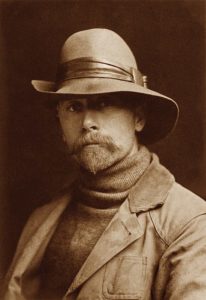
Edward Sheriff Curtis was born near Whitewater, Wisconsin in 1868. He became interested in photography as a young child and even built his own camera. He later owned a successful photography studio in Seattle, Washington. Curtis is best known for his photographs of Native Americans. He created a series of books called North American Indian that included his photographs as well as well as information about the various tribes. For thirty years he visited more than eighty tribes all over the nation to record their customs and traditions by taking over 40,000 photographs and 10,000 recordings of Native American music and language. He believed that Native American culture should be kept safe and wanted to document it before the traditions disappeared.
Between 70 and 150 medicine wheels have been identified in South Dakota, Wyoming, Montana, Alberta, and Saskatchewan. Medicine wheels are Native American sacred circular hoops which are used for religious rituals. This is a form of divination. Medicine wheels are usually numbered stones kept in the form of a circle. They are used in Native American spiritual healing rituals. Each stone has its own significance and is thought to help in solving your problems.
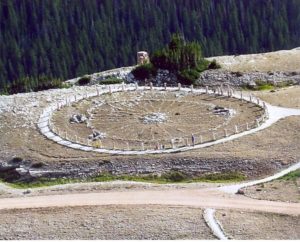
The Bighorn Wheel in Wyoming was constructed by Plains Indians between 300-800 years ago, and has been used and maintained by various groups since then. The central cairn is the oldest part, with excavations showing it extends below the wheel and has been buried by wind blown dust. It may have supported a central pole. The star alignments are most accurate for around 1200 AD, since slight changes in the earth’s orbit have caused perturbations since. The solstice alignments remain accurate today.
The Indian protests that began in the 1960s had to do with the conflict over remaining natural resources of the continent, the best of which were in Indian hands. In the 1970s a full national Indian movement was in swing. Beneath all of their protests was the issue of returning to the ceremonial use of the lands and raising the question of people and their right to a homeland. In 1971 anthropologists and archaeologists were confronted with “disturbing the dead” whenever they came across something of the Indians in their field work. By 1900 the Chicago Field Museum played a major role in bringing the museum community to see the Indian point of view. It participated in Indian/museum dialogue that led to national legislation repatriating human skeletal remains to the tribes. (29; Deloria)
The Bighorn Wheel is part of a much larger complex of interrelated archaeological sites that represent 7000 years of Native American adaptation to and use of the alpine landscape that surrounds Medicine Mountain in Wyoming. Numerous contemporary American Indians use the ceremonial staging areas, medicinal and ceremonial plant gathering areas, sweat lodge sites, altars offering locales and fasting (vision quest) enclosures, can be found nearby. Ethno historic, ethnographic and archaeological evidence demonstrates that the medicine wheel and the surrounding landscape constitute one of the most important and well preserved ancient Native American sacred site complexes in North America.
Native American scholar and author Vine Deloria, Jr., writes, “I can think of no good reason why the peoples from the Near East, ‘the peoples from the Hebrew, Islamic, and Christian religious traditions,’ first adopted the trappings of civilization and then forced a peculiar view of the natural world on succeeding generations. The planet, in their view, is not our natural home and ours is for total exploitation. The world is not to be seen as a global village so much as a series of non-homogeneous pockets of identity that must eventually come into conflict because they represent different historical arrangements of emotional energy. We must be prepared to confront religion and religious activities in new and novel ways.” (29, p.65) “The government and the Christian churches have no understandings of the nature of creation. At the bottom of everything is a religious view of the world that seeks to locate our species within the fabric of life that constitutes the natural world, the land and all its various forms of life. As long as Indians exist there will be conflict between the tribes and any group that carelessly despoils the land and the life it supports.” (29; Deloria)
According to the Christian Bible, after the Flood, God caused the people of the world to speak many different languages and scattered them from the Tower of Babel “upon the face of the earth” (Genesis 11:9). The first people to come to America were probably hunters following the trail of animals that had begun to multiply and spread out. The early Indians had forsaken the things that their ancestors knew about God. They passed down inaccurate stories about the Creation and the Flood and they worshiped the things that they could not explain, like thunder, wind, fire, and the sun. Although the Indians are views in awe by many because of their appreciation of nature, they have not always lived in peaceful ways or ways that were good for the environment. They did not always behave in ways that were the best for the family either. Their religious leaders were called medicine men. Not only were wars between the tribes common as many tribes shifted to new areas and pushed existing tribes off the land, but an account of some of their ceremonies could outdo any of the current attacks on Spain’s conquistadors or the Puritans and their beliefs.
In the 1700s Rousseau’s ideas were promoted. He said that man himself is the only god and the most primitive man, the one who is the closest to nature, is the purest. When Columbus first met the Arawak Indians they warned him about the fierce Indian tribe of cannibals called the Caribs. The Caribbean Sea is named after them. Both the Arawaks and the Caribs practiced a pagan, pantheistic religion that involved many immoral practices. In Cowboy Wash in southwest Colorado archaeologists have unearthed three collapsed pit dwellings that had been abandoned in the 1100s. The bones of seven people were found in the cooking pots with clear evidence they they had been eaten. According to scientist Richard Marlar at the University of Colorado, “They had a human meat meal.” For at least 600 years the Anasazi Indians spread through what is now Utah, Colorado, Arizona, and New Mexico. But by the year 1300 they mysteriously vanished. (51; Thompson)
The Maya also practiced pagan religion with human sacrifice and between 1519-1521 Cortez conquered the Aztec Indians with the help of neighboring tribes who had been victims of human sacrifice for the Aztec’s worship of the gods of nature. Although they had and advanced civilization, they worshiped hundreds of gods. They centered their worship on the “sun god.” They believed that they were chosen people of the sun god and that they needed to supply him with human sacrifices. They judged their righteousness solely on the submission to the gods. (51; Thompson)
New Agers claim the early Indians were champions of harmony and wisdom, but they were not. Native tribes in the Americas offered hundreds of thousands of human sacrifices to their gods. Facts about pagan cultures are being hidden and history is being rewritten as the American culture has turned its back on God. Christianity is mocked and even censored in the public schools as the “Gaia Hypothesis” is now being taught. Initially articulated by chemist James Lovelock, Lovelock concentrated on the nature of the earth’s atmosphere and argued that “the entire range of living matter on earth, from whales to viruses, from oaks to algae, could be regarded as constituting a single living entity, capable of manipulating the earth’s atmosphere to suit its overall needs and endowed with faculties and powers far beyond those of its constituent parts.” (30; Lovelock)
Rolling Thunder, the Shoshone Indian medicine man has said, “Scientists will eventually discover what pagans have always known.” That’s exactly what is happening with the invasion of Eastern’s mysticism into the West. Hinduism is taught at all schools across the United States k-university. Hindu occultism is being openly taught in spite of the otherwise enforced separation of church and state. (31; Hunt)
More recently, syncretic, hybridized uses of medicine wheels, magic circles, and mandala sacred technology are employed in New Age, Wiccan, Pagan and other spiritual discourse throughout the World. The rite of the sacred hoop and medicine wheel differed and differs amongst indigenous, as it now does between non-indigenous peoples, and between traditional and modernist variations.
Wherever people are engaged in ritual practice, mandala are form evolves. Geometric art has been used throughout the ages for meditation. Authors of “Gaia Star Mandalas,” Bell and Todd had always been inspired by sacred art, especially from the Hindu and Buddhist traditions. They share that their art emerged from a trancelike state of perceptional openess. They believe that they had contact at a core level with our planet and they found the mandalas as a way to “notate,” in a visual way, the vibrational essences they drew from their contact.
The mandala is a classic form of this contemplative art, which originated in India. Mandalas have a long tradition in diverse cultures like the Buddhist, Hindu, and Native American. The intricate patterns draw the viewer to the center of the image and spin them out of the vortex, thereby centering the soul and expanding your cerebral boundaries. These art forms are created to invite all people to connect with this visual message about the union of spirit and matter. Gaia is an ancient name for earth as goddess…an emerging being is emerging; and emerging global being is forming in our midst. This Gaian entity contains countless diverse species of life forms. Just as differentiated cells organize to form a complex body, myriad individual aspects of Gaia are coalescing into a new kind of planetary unity. This is happening electronically through the worldwide computer web, but it is also happening at profound levels of biological and spiritual identity. The global being is taking shape where grand laws of self-organization intersect with a planetwide intention to make a quantum leap. From this fertile conjunction, a familiar yet uplifted Earth emerges; luminous, self-aware, awake as many-in-one. This is a turned-on world–the Gaiastar. (39; Bell & Todd)
His Story
“In the beginning was the Word, and the Word was with God. He was with God in the beginning. Through Him all things were made; without Him nothing was made that has been made.” John 1:1-3
The Trinity, the Triune God existed and is eternal. Prior to the creation of the universe, the Word of God existed. There are indications in the Scriptures from the genealogies in Genesis 5 and 11, and the way they are written, that there is evidence to believe that the creation event took place some 4,000 years before Christ. The agent of this event, in verse 1, “In the beginning ‘God’ created the heavens and earth.” The only true God; the only self-existent divine Being consisting of Father, Son and Holy Spirit–Omnipotent, omnipresent and omniscient. He has always existed and was created by no one. This is who created the universe.
“Before the mountains were born or you brought forth the earth and the world, from everlasting to everlasting you are God.” Psalm 90:2
“By faith we understand that the universe was formed at God’s command, so that what is seen was not made out of what was visible.” Hebrews 11:3
Only Creation explains the difference between man and animals, it is an unbridgeable chasm. God created man altogether greater than any higher animal because we are created in His image. Only Creation explains moral nature. Every single tribe of people throughout history has had a moral value system; a distinction between right and wrong. This comes from the conscience that was planted in man’s heart. The consciousness of his moral nature is the basis of all law and sanity and of all purpose and meaning in life. This is not from a psychological transformation of any cell because we are now talking about the area of the soul.
“Then God said, ‘Let us make man in Our image, in Our likeness, and let them rule over the fish of the sea and the birds of the air, over the livestock, over all the earth, and over all the creatures that move along the ground.” Genesis 1:26
This is the separation between man and everything else. The Trinity is also being taught to us in this verse, too: “Let ‘Us’ make man in Our own image.” Withing the moral universe in which we live, the existence of the concept of good and evil and sin and death is only explained by the Genesis Creation account.
“For by Him all things were created: things in heaven and on earth, visible and invisible, whether thrones or powers or rulers or authorities; all things were created by Him. He is before all things, and in Him all things hold together.” Colossians 1:16, 17
The whole universe did not exist prior to Genesis 1:1. Evolution believes that matter and the universe are eternal; the eternality of matter. That viewpoint is really a pagan viewpoint. The universe was created out of divine fiat; by the spoken word of God. God spoke and it all came into existence. His eight commands explain everything in the universe. In speaking the universe into being, God was willing that it should appear and become, and it did. His thought was shaping it exactly from the least cell in Adam to the furthest star and galaxy in the same moment. For in Him all things were created and in Him all things hold together. He spoke a word and things came into existence. This power is resident in the Word that we have written in the Bible as well. Hebrews 4:12 says that the Word is alive and active and powerful.
The word for days in Genesis is “yom.” The normal meaning of “yom” is a 24 hour day and whenever “yom” occurs with a number like “the forth yom” it is always a 24 hour day. When it announces “there was a morning and an evening” we can’t mistake the fact that it is a 24 hour day. The next question is “why six days?” The answer is in Exodus 20:9-11 in the giving of the Ten Commandments, “Six days you shall labor and do all your work, but the seventh day is the Sabbath to the Lord your God. On it you shall not do any work, neither you, nor your son or daughter, nor your manservant or maidservant, nor your animals, nor the alien within your gates. For in six days the Lord made the heavens and the earth, the sea, and all that is in them, but he rested on the seventh day. Therefore the Lord blessed the Sabbath day and made it holy.” God gave mankind a pattern, an example. He applied it to Israel in the strictest way of the Sabbath Day being observed, but it is nevertheless a pattern for mankind to set aside a seventh day for worship and rest in their schedule. The world was created in “ex nihilo,” out of nothing, by divine fiat, by the spoken word of God, and in order by days.
“Because that which may be known of God is manifested in them; for God hath shewed it unto them. For the invisible things of him from the creation of the world are clearly seen, being understood by the things that are made, even his eternal power and Godhead; so that they are without excuse. Because that, when they knew God, they glorified him not as God, neither were thankful; but became vain in their imaginations and their foolish heart was darkened. Professing themselves to be wise, they became fools. And changed the glory of the incorruptible God into an image made like to corruptible man, and to birds, and four-footed beasts, and creeping things. Wherefore God also gave them up to uncleanness through the lusts of their own hearts, to dishonor their own bodies between themselves. Who changed the truth of God into a lie, and worshiped and served the creature more than the Creator, who is blessed forever, Amen. And likewise, also the men, leaving the natural use of the woman, burned in their lust one toward another; men with men working that which is unseemly, and receiving in themselves that recompense of their error which was meet. And even as they did not like to retain God in their knowledge, God gave them over to a reprobate mind…” Romans 1:19-28
In all creation, it is evident that His fingerprints are there. That man can look at what has been made, and with the reason that God has given, man can come to the conclusion properly that God created this. Because man denies, that is evidence of the sinfulness of man and the fallen depraved minds that we have today. Only Creation explains the intricate order of the universe. You cannot explain the degree and the depth of order in our solar system and our planetary system and in life by random chance. The geometry of nature, the construction of cells and the growth, the efficiency of nature…. When you pick and orange off a tree–that’s packaged fruit.
The Bible declares that man began at the top and because of sin fell to the bottom. This contradicts evolutionary social philosophers that teach that all of mankind social ills are a product of either hereditary or environmental problems. They are simply denying man’s depravity, man’s original sin. Legislators will not be able to create the perfect environment, and men will never obtain ultimate ideals. Genetics will not be able to reprogram and improve man to rid him of all the evil and pain in this world. Man has already been tested under the most favorable conditions and he failed. Man’s problem today is not external, it is eternal. (32; Mooberry)
Timeline
- 33-312: The Church permeates the Roman Empire. Christians are persecuted through the emperors and Jewish leaders.
- 321: Christianity becomes the religion of the empire through Constantine, but the “patchwork” of Christianity, called Christiandom, included many pagan beliefs and was not pure Christianity. (42; Foster & Ball).
- 500-1200: Barbarian Europe is converted–Europe, England, and Scotland.
- 625-1436: Islamic hoarders ravage Asia Minor, Africa, and Europe.
- 1345: A plague descends on Europe; 30-50% die. John Wycliffe begins a grassroots revival which is countered by humanism of the Renaissance and neoclassical paganism which permeates the Catholic hierarchy.
- 1492-1620: America is opened up after 5,000 years of isolation and Christianity is brought to its shores. The Gospel is deflected away from much of Europe as Christianity is countered by the Enlightenment, European rationalism and the French Revolution. Many people believed that reform was needed in England’s national church. It was a Protestant church run by the House of Bishops and the head was the English monarch. The rulers of England tried to force all of the people of England to believe the same things about God and those who disobeyed were persecuted. Many people wanted worship services to include Bible readings and personal prayers and they wanted to do away with many of the rituals. The Puritans remained loyal to the Church of England, but they wanted to purify it the Separatists “separated” themselves and began their own worship services. The bishops viewed the Separatists as a threat and many were persecuted in England so they left.
- 1500s: Many Spanish ships crossed the ocean to the New World to merely conquer and discover gold.
- 1517: The Reformation begins through Martin Luther, John Calvin, and John Knox. This is countered by “the divine right of kings” and millions are killed in 100 years of religious wars.
- 1540s: The burning of religious heretics was still a way of life in Scotland. As the nobility and Cardinal took their padded seats to watch the burning of George Wishart, little did they know that Wishart’s bodyguard and friend, John Knox, would liberate Scotland in another decade. As the flames rose, Wishart declared to the Cardinal, “He who from yonder place beholds me with such pride, shall within a few days lie in the same as ignominiously as he is now seen proudly to rest himself.” Sure enough, not long after the execution, the Cardinal’s enemies broke into his chambers and ran him through.
John Knox (c. 1505-1572) became Wishart’s successor, trying to bring true Christianity to Scotland, though he was an improbable leader. From obscure origins, a defrocked priest, ugly, undiplomatic, socially graceless and full of fire, John Knox seemed ill-equipped to face off a thousand years of Catholic rule. Before he could even get started , he was captured by the French and placed in a French warship as a galley slave (oarsman). When he was released he was forced to flee to the continent where he spent four years strengthening his mind and soul in Geneva, under the teaching of the great Calvin at his school of reformers. When Knox returned to Scotland in 1588, he was shot at and chased at from place to place, but he proclaimed Christ’s Lordship and, within two years, he defeated the Roman Catholic Church and the Godless Queen Mary herself. He had done so largely by preaching and converting the people to the truth, not just by the power of the sword.
Under Knox’s influence Scotland became a “people of the book” and adopted Presbyterian church government. This Christian heritage that brought the government of God back to the people and elders, as opposed to the King and the Pope, became the major force for the founding of the republican government in America a century later. The reformation of Scotland under John Knox resulted in the exile of Mary, Queen of Scots, to England. She was placed under arrest for twenty years as a danger to Queen Elizabeth’s throne (her cousin). As the Spanish Armada was threatening the destruction of Protestant England, Elizabeth was convinced to behead Mary. To cover her guild, Elizabeth blamed her secretary, Davidson, for tricking her into signing the death warrant. He was thrown into prison, and his young assistant, who might have had a successful future at court, lost his position and went back to Scrooby Manor. This young assistant secretary to Queen Elizabeth was William Brewster.
- 1588: The Bible is printed in the language of the common man, bringing revival to England. Unreached nations are left in darkness through ignorance of God’s Word and Truth.
- 1603: William Brewster took over his father’s job as the postmaster of Scrooby in 1603 and started an underground church which met in the basement of the manor house. In that same year, a young boy from a dysfunctional family in a village 12 miles from Scrooby began to attend church. He was 13 years old, and his name was William Bradford. Bradford was unofficially adopted by William Brewster and his wife Mary. He and about 38 others met secretly until about 1607, when King James I began to persecute them out of England. In 1608, the little congregation moved to Holland and settled in Leydon. Here William started a clothing business at the age of 20 and married a young English exile, Dorothy. For 10 years they struggled to survive as exiles, as William moved into leadership of the church along with Pastor John Robinson and William Brewster. (42; Foster & Ball)
- 1620: The Pilgrims (Separatists) land at Cape Cod. Landing off course left them with the need to settle their own authority. William Bradford set up the elected form of government which was called “The Mayflower Compact,” this is the prototype for our national liberty. This was the first time that free and equal men had ever entered a covenant to create a new society, based on Biblical principals. One of these principles was that “all men are created equal in the sight of God.” A second was that “a government must only govern people who agree to submit to it.” These two principles became the cornerstones of America’s constitutional government. Bradford became governor of the Plymouth Colony for the first of 31 terms. He wrote the only complete history of the Plymouth settlement in a diary stretching 40 years. He turned the colony from Communism to free enterprise, insuring its prosperity. Threatened with starvation, Squanto helps the pilgrims survive and they celebrate their first “Thanksgiving Day.”
- 1630: A group of about 1,000 settlers landed in Massachusetts Bay and founded the city of Boston. Within 20 years of the first Puritans arriving in America there were 20,000 English people in Massachusetts. Some moved to Rhode Island and Connecticut.
- 1636: Harvard University is founded in Cambridge, MA. When the Pilgrims came over on the Mayflower they brought history books and theology books and thought that it was all you need to start a university. Theology is the study of God and His Word and history is the study of God and His Word worked out in time and space.
- 1758: Noah Webster began writing the first American dictionary in 1807. He is also the writer of the first American textbooks for children.
- 1776-1783: The American Revolutionary War. American colonists fought for their freedoms from England. The Declaration of Independence was approved on July 4th, 1776. In this paper Americans said they were free from the rule of the king of England. Although some professing Christians were instrumental in colonizing the continent early on, the U.S. government was never formed to establish a Christian nation. In truth, many of the framers of the Constitution were at best Freemasons who were also church people, and at worst deists who denied the Lord Jesus Christ and even the very nature of the personal God. Yet, they wrote that document for a biblically-oriented people. Today the biblical ethic is no longer the guiding force for American society. But, in reality, every nation is always “under God.” (23; Dager)
- 1776-1783: Subtle strategies of compromise begin to spread as churches were infiltrated by half-truths and deception through Unitarianism, evolution, Marxism, and a classic revival of neo-pagan immorality. (42; Foster & Ball)
- 1790: The first census is taken in the United States.
- 1861: Civil War begins at Fort Sumter, South Carolina.
- 1863: Abraham Lincoln delivers the Gettysburg Address at the dedication of the Gettysburg National Cemetery in Pennsylvania.
- 1865: Slavery is abolished; Lincoln is assassinated.
- 1869: The first railroad linking East with the West Coasts of the United States is completed.
- 1870: Congress passes the 15th amendment granting the right to vote regardless of race, color, or previous condition of servitude.
- 1873: P.T. Barnum opens his circus, “The Greatest Show on Earth,” in New York.
- 1874: The first American zoo is established in Philadelphia.
- 1876: Alexander Graham Bell is granted the first U.S. patent for the telephone.
- 1876: The Battle of Little Big Horn. The Sioux Indians, led by chiefs Sitting Bull and Crazy Horse, defeat General Custer and the Seventh Calvary.
- 1877: The phonograph was invented by Thomas Edison.
- 1885: The one-room schoolhouse is replaced by the graded school on September 4th in Stratford, CT.
- 1886: Coca-Cola appears on the market in Atlanta, GA and is advertised as a remedy for fatigue.
- 1891: With more leisure time, basketball is played for the first time in North America. Proper rules for football and baseball were also introduced.
- 1903: Orville and Wilbur Wright successfully fly a powered airplane in Kitty Hawk, NC. 1905: Albert Einstein formulates the Theory of Relativity with the equation E=mc2.
- 1908: Henry Ford manufactures the first Model T automobile.
- 1909: Lincoln-head is issued. On the 100th anniversary of Abraham Lincoln’s birth the Philadelphia mint replaces the Indian-head penny.
- 1912: The Titanic sinks. The unsinkable luxury liner making its maiden voyage from England to the United States, collides with an iceberg and sinks, killing 1,513 people.
- 1920: During the economic boom of the “Roaring Twenties,” the traditional values of rural America were challenged by the Jazz Age, symbolized by women smoking, drinking and wearing short skirts. The average American was busy buying automobiles and buying household appliances “on credit,” and speculating in the stock market.
Just 150 years ago, the evolutionary theory combined with societal circumstances drastically shifted our attitude toward time. Time was once arranged by families as in European history when we had the Stuarts, Hapsburgs, Bourbons, and so on. Now we speak of the sixties, seventies, and eighties. The industrial revolution brought a greater need for schedules with the railroads and factories. Greenwich, England became the prime meridian in 1884. This fixed the exact length of a day and divided the globe into 24 time zones. In the 1859 census, age was not yet included. Even birthdays were neither mentioned nor celebrated before the mid-nineteenth century. (50: Dager)
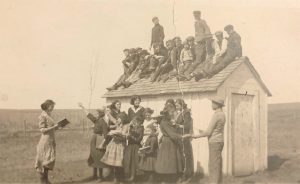 With the onset of evolutionary thinking, progress soon became synonymous with the passage of time and students were segregated by age. Students were now judged to be either “ahead” or “behind” their peer group. The one-room school house had been the norm since there was no impetus to segregate based on maturity level. At the turn of the twentieth century, Granville Stanly Hall used the social applications of Darwin’s work in Biology and suggested that individuals evolve through the same stages through which human history has evolved. Infants and toddlers were associated with pre-savage periods of human history; he counseled parents and teachers to leave their young children to Nature and encourage play which fosters motor development. Likened to the early pygmies and other savages, a crisis period of transition led to the pre-adolescent years of 8-12; these children could be drilled and disciplined in school. Then another period of crisis came at adolescence, which he deemed the most critical period in one’s life. In his greatest work, Hall developed this theory in which he called his “recapitulation theory” in a two-volume tome titled “Adolescence: its Psychology, and its Relations to Physiology, Anthropology, Sociology, Sex, Crime, Religion and Education. (31: Hunt)
With the onset of evolutionary thinking, progress soon became synonymous with the passage of time and students were segregated by age. Students were now judged to be either “ahead” or “behind” their peer group. The one-room school house had been the norm since there was no impetus to segregate based on maturity level. At the turn of the twentieth century, Granville Stanly Hall used the social applications of Darwin’s work in Biology and suggested that individuals evolve through the same stages through which human history has evolved. Infants and toddlers were associated with pre-savage periods of human history; he counseled parents and teachers to leave their young children to Nature and encourage play which fosters motor development. Likened to the early pygmies and other savages, a crisis period of transition led to the pre-adolescent years of 8-12; these children could be drilled and disciplined in school. Then another period of crisis came at adolescence, which he deemed the most critical period in one’s life. In his greatest work, Hall developed this theory in which he called his “recapitulation theory” in a two-volume tome titled “Adolescence: its Psychology, and its Relations to Physiology, Anthropology, Sociology, Sex, Crime, Religion and Education. (31: Hunt)
Some people embraced Darwinism for philosophical reasons; they wished to remove God from their thinking. Others simply believed that it was scientific. But Darwin’s philosophy of evolution had little to do with science. In fact, one of Darwin’s first supporters was a liberal Anglican clergyman and socialist, Charles Kingsley, who worked hard to integrate the ideas of evolution into Christian practice—most scientists were skeptical because they realized that it was based largely upon speculation rather than scientific fact. The acceptance or rejection of evolution was not dependent upon one’s scientific knowledge or aptitude, but upon one’s readiness to find a materialistic explanation for life (one’s faith). This caused a dramatic shift away from the traditional Judeo-Christian worldview toward a naturalistic worldview. Instead of being a special creation of God, mankind became regarded as a mere animal, with no more worth than any other part of nature. Right and wrong became to be thought of as relative, defined either by the whims of the individual or by the will of the majority. (34: Sarfti)
Rebellion was actually viewed as a positive thing as Hall taught that each generation is or should be superior to the previous one, and therefore needs to break free from those which precede it. Hall’s renowned follower, John Dewey, later applied these theories to the public school system. Dewey taught a generation of teachers and school administrators through his laboratory school for progressive education at the University of Chicago. He created high schools to segregate teens from other children and from adults. Within a generation after Dewey, an adolescent sub-culture emerged. By the 1950s, teens had their own music, language, and dress. The fifties’ James Dean’s movie “Rebel Without a Cause” contained the theme that the nobility of youth suffers at the hands of an evil older generation which lacks understanding. Elvis Presley would soon promote certain hair styles, dress, and attitudes that became legendary. Then, Dustin Hoffman would deal the final blow at parental authority and respect in movie “The Graduate.” Today the youth culture is the “dominant culture.” (31: Hunt)
- 1929: Black Tuesday, October 29, 1929, the stock market crashed triggering the Great Depression. It spread from the United States to the rest of the world, lasting from the end of 1929 until the early 1940s. More than 15 million Americans became unemployed. President Herbert Hoover, a strong believer in rugged individualism, did not think the federal government should offer relief. Focusing on a trickle-down economic program to help finance businesses and banks, Hoover met with resistance from the business executives who preferred to lay off workers. Most Americans were able to provide for themselves, and others received help from family, friends, and private charities. Certain leaders, however, began to convince people that the government should solve their financial problems and many people began to depend on it for their financial needs. By 1932, the Depression was at its worst, and many people were open to socialistic ideas of government control and economic planning. (37; Pensacola)
When Franklin D. Roosevelt took the oath of office the Great Depression had reached its lowest depths. In the proposals that FDR made to congress, he followed the advice of a group of close advisers, mostly college professors, who came to be known as the “Brain Trust.” They urged the adoption of untried and unproven economic theories of John Maynard Keynes. Keynes was a British left-wing economic theoretician who advocated central planning and massive economic and social intervention on the part of government in order to bring a nation out of economic recession or depression. Keynesian economics and New Deal legislation were aimed at “spending the nation into prosperity.” This set a precedent for direct government intervention and involvement in the lives and property of the American people moving them away from Thomas Jefferson’s dictum, “That government is best which governs least.” (37; Pensacola)
- 1933: On April 19, all privately held gold was to be turned into the Federal Reserve banks in exchange for paper money. Taking the country off the gold standard shook public confidence in the U.S. monetary system. This abandonment of the gold standard helped create a “managed currency” in the United States. In 1934, in an attempt to stimulate the economy by creating inflation, the federal government reduced the gold value of the dollar to 59.06 cents, or 59.06 percent of its former value. Now paper currency, which was already unredeemable, was only partially backed by gold. The American tradition of free enterprise and individual initiative, which had made the country great, was being replaced by an ever-expanding, paternalistic federal bureaucracy. The staggering cost and long-term inefficiency of the New Deal also brought it much criticism. The national debt soared upward and unemployment remained a problem. (37; Pensacola)
- 1946—In 1946, with the end of Soviet Communism, Winston Churchill had delivered a speech at Westminster College in Fulton, MO, proclaiming: “From Stettin in the Baltic to Trieste in the Adriatic an iron curtain has descended across the continent.” Forty-six years later, on May 6, 1992, Mikhail Gorbachev returned to Fulton as the last leader of the Soviet Union. Gorbachev had fostered the reforms that went beyond his own expectations and led to the dissolution of the Soviet Union. (49: Microsoft Encyclopedia)
The ultimate weakness of Soviet Communism can be traced to many sources. Despite their ideological commitment to human equality, the Communists established a party elite in the Soviet Union, leaders who were, as George Orwell commented in his allegorical fable “Animal Farm,” “more equal than others.” As an economic system Communism was also found lacking. Allowing little scope for human initiative, Communists failed to draw out the best efforts of the Soviet peoples as producers and distributors of goods. Communism relied on “controlled press” that printed only what the government wanted the people to hear. Romania even required its citizens to register their typewriters. (49: Microsoft Encyclopedia)
The Nazis called their government the “Third Reich” (Third Empire). The first was the Holy Roman Empire and the second was the German Empire. Many were attracted to National Socialism because it linked everything, or nearly everything, together—the workers “by brain and by hand” were no longer apart, employers and employees were no longer opponents, and town and country were merged in the nation. Romantic talk of Blut and Boden, “blood and soil,” and the simple life of the farmer…Folk dancing and the residential settlement movement…and “Strength through Joy” allowed many to join in and give them identity. Within the labyrinth of modern society the Nazi dictatorship opened up spaces where no law applied, except the Fuhrer’s command. The past meant nothing; at best it was a dark period that had to be overcome—the Hitler youth referred to old people as mere “cemetery vegetables.” (47: Sturmer)
The guardian state supplied universal care, but also intrusive supervision. Concentration camps, Gestapo, block wardens and Party bigwigs all existed, but it was better to look the other way. For those with doubts, there was a defensive mechanism in the phrase: “If only the Fuhrer knew…” The Nazis seized control of the nation’s courts, industries, newspapers, police, and schools. Many children were taught to spy, even on their parents, for the Nazis. Those who opposed the Nazi dictatorship were murdered, imprisoned in concentration camps, or beaten up by Hitler’s private army of hoodlums, called storm troopers. (48: World Book Encyclopedia)
Goebbels (the Gauleiter of Berlin) recorded that the vegetarian Hitler “has little regard for homo sapiens. Man should not feel so superior to the animals.” Josef Goebbels was a pupil of the Jesuits from the Cologne region who became “Reich Minister of Public Enlightenment and Propaganda.” (47; Sturmer)
Some people embraced Darwinism for philosophical reasons; they wished to remove God from their thinking. Others simply believed that it was scientific. But Darwin’s philosophy of evolution had little to do with science. In fact, one of Darwin’s first supporters was a liberal Anglican clergyman and socialist, Charles Kingsley, who worked hard to integrate the ideas of evolution into Christian practice—most scientists were skeptical because they realized that it was based largely upon speculation rather than scientific fact. The acceptance or rejection of evolution was not dependent upon one’s scientific knowledge or aptitude, but upon one’s readiness to find a materialistic explanation for life (one’s faith). This caused a dramatic shift away from the traditional Judeo-Christian worldview toward a naturalistic worldview. Instead of being a special creation of God, mankind became regarded as a mere animal, with no more worth than any other part of nature. Right and wrong became to be thought of as relative, defined either by the whims of the individual or by the will of the majority. (34: Sarfti)
Identical to the New Age Movement of today, the Nazi worldview also grew out of the same occultic root: theosophy. In fact, the New Age Movement could easily bring forth another Adolf Hitler as well as another holocaust. Joseph Carr, in his book “The Twisted Cross,” exposes that the Nazi’s worshiped pagan gods and the Gestapo conducted Mystery initiation rites and swore blood oaths to Satan, and the top Nazi leaders were dedicated students of the black magic arts and witchcraft. The Nazis also believed in evolution, karma, and reincarnation, which are all New Age concepts. (46: Bailey)
Although occult literature calls the “New World Order” a “Golden Age,” the Bible describes it as a time of sorrow. Aurelio Peccei, co-founder of the Club of Rome, hold an occultic worldview, biases against Christianity, and believes that orthodox religious beliefs are primitive: “One of the greatest socio-political and economic differences between the future and the present is that the increasingly intertwined structures of the entire global system will produce ‘A Progressive Convergence of the Futures of all Peoples.’ All societies will be bound together even more closely by a network of vital interlinkages, which will condition their relationships with each other for better or for worse. Breaking these links will no longer be conceivable. It would throw the whole system into chaos—which no one would want.” If these links of which he speaks are truly unbreakable, individual freedoms are very much a thing of the past. Peccei also justifies the establishment of a new universal religion: “….Certain points of doctrine…. have been magnified, provoking schisms, apostasy,.. ‘Without A Sincere Spiritual Awakening, The Renaissance of our True Humanity Will Be Impossible.’” (45: Peccei)
The act of unifying underlies all of occultism. It is a false syncretistic unity instead of true unity in Jesus Christ. The dangers of trying to gain control over society should be self evident. Those who feel we should so will be receptive to a dictatorship that the antichrist will ultimately impose. Under the new world view, national sovereignty will be unjustifiable. National sovereignty is the right of each individual nation to act as an individual nation, making its own laws and executing its own laws among its people. To the internationalist, national sovereignty is the epitome of global selfishness. Nations need to share their wealth and resources with other nations to eliminate present problems of other countries. To the new world advocate, there is no other viable alternative to the future survival of civilization than of a new global community under a common leadership! (44: Carr)
- 1960s: During the 1960s Americans desperately sought alternatives to their parent’s religious lifestyles. These religious seekers “looked within” for truth and wisdom. Meditation was widely incorporated along with witchcraft covens, communal gatherings, Zen retreats, and new movements like Transcendental meditation and Krishna Consciousness. Family relationships, diet, fashion, and exercise were all areas in which “good” and “bad” were measured by their effects on self-knowledge and personal growth. Whereas religious and political leaders once held back the occult in America, moral authority is now increasingly located in the self rather than in family, church, or nation. A morality-free society was pushed and the results were the ingestion of drugs, sexual experimentation, rebellion against conformity to society’s norms, and a gradual dissolution of differences between men and women. To a large degree, mass media promoted the rejection of the traditional morality. (37: Pensacola)
- 2000–Today, both Communism and the Arabs are a threat to our society. Not only was 9/11/01 a wake-up call, but today we are aware, with the many mosques going up across the country, that some are secretly preparing jihad to the United States. Although we brought down the Soviet Union, the agenda of that corrupt system is alive and well in this country’s academia, media, governments and churches.
Today, individual liberty means individual license to do as one pleases. “You can’t legislate morality” is their cry, in spite of the fact that most governments that have ever existed have based their laws upon a moral framework that distinguishes between right and wrong. Those that do not will fall into despotism, creating havoc and poverty for their citizens. (32; Mooberry)
Colonials disapproved of blending Christianity and astrology and saw magic as evil and demonic. But after 1720 immigrants from Europe challenged the Protestant worldview and irrevocably changed the cultural landscape of America. People were encouraged to shape their own destinies and this optimism and emphasis on personal experience became a basic assumption underlying mid-nineteenth alternative religious movements. The reformist agenda was initiated by a transformed social and economic landscape and revivalism’s emphasis on the ability of humans to direct their own lives and to perfect the world around them. The Second Great Awakening (1800-1830) was also a time of spurred interest in many alternatives to Christianity. The “psychic highway” followed the Erie Canal through New York west of the Catskills and the Adirondack Mountains. Rochester and Utica became known as the “Burned-over District” as religious revivals spread across the district. Early Mormonism was started there as well as Spiritualism, which eventually developed in different directions.
During the years from 1812-1860, a “hothouse” atmosphere surfaced for social experimentation and religious creativity. As our country moved into commercial greatness, crowded cities staged popular speakers and held demonstrations were political and religious ideas were exchanged. (36; Pike)
Today, right and wrong have lost their meaning because, according to modern psychology, none of us is responsible for anything we do. We are all victims, driven to do whatever we do by the traumas we suffered as children, traumas which have created hidden motives and urges buried in the unconscious and are thus unknown to us and beyond our control. Before Freud, no educated adult could find a plausible reason to avoid responsibility for his actions. Left to psychoanalysis and psychodynamic psychology, man has become blameless. It is not done by covering his faults, but by tracing them back to his childhood, when he was morally innocent… (31; Hunt)
A “Reader’s Digest” article commented: “….Sin isn’t something many people spent much time worrying about in the past 25 years. But…sin…at least offered a frame of reference for behavior. When the frame was dismantled during the sexual revolution, we lost the guide wire of personal responsibility… The United States has problems with drugs, high-school sex, AIDS and rape. None of these will go away until people in positions of responsibility come forward and explain, in frankly moral terms, that some of the things people do nowadays are wrong.” (Reader’s Digest, May 1992, reprinted from the Wall Street Journal).
On December 5, 1980, the United Nations General Assembly formulated the Global Education Project. Based on UN assistant secretary-general Robert Muller’s World Core Curriculum, a model for global education for every nation was set up in Costa Rica called the University for Peace. Stressing “thinking skills” rather than academics, it is designed to instill non-competitive group consciousness, critical thinking, and global citizenship. Muller is an evolutionist who believes man is about to take a quantum leap toward becoming a new species. He believes that the earth is going to be transformed into the “planet of God.” To him God is the “planetary age” or the “age of Aquarius.” He agrees with the Hindus in calling the earth God. This is the foundation of our radical environmentalists today. They are striving for a spiritual at-one-ment with nature—a unified world system where the individual is subordinated into the whole. This World Core Curriculum promotes Eastern meditation techniques, including “guided fantasies into space,” which is also called “out-of-body travel” or “astral projection.” Muller’s concepts are actually taken from occultist Alice Bailey’s writings which were channeled the spirit guide Djwhal Kuhl, also known as the Tibetan. These channeled spirit guides are from an alleged group of evolutionary beings who have attained a high degree of evolutionary perfection which released them from bondage to the material world. This holistic view of life views the planet as interconnected, with no life form having any greater standing than any other life form. Imperfect while we are still man, our next stage is said to take us to a level that is psychologically, spiritually, and physically superior where we will be a true “planetary citizen.” (40; Dager)
The overall paradigm shift:
- Patriarchal (Father God)—– Matriarchal (Mother Earth—Gaia)
- Hierarchical Leadership—–“Decentralized”—Totalitarian in a Crisis
- Accountability to God—–Accountability to fellow man/earth
Scripture tells us that man’s inward thoughts and intents of the heart are corrupt (Jeremiah 17:9). Scripture also tells us that the love of many will grow cold toward the end of the church age and that sin will abound (Matthew 24:12). Even in the Millennium Jesus and His saints will need to rule with a “rod of iron” against those who will rebel against His government (Rev. 2:27; 12;5, 19;15).
God always allows evil to exist in the world to test the hearts of men so that none will be without excuse. We are not to take for ourselves what He has not ordained. Western Civilization has largely been shaped by the esoteric philosophies of secret societies working through the influence of members in strategic political positions. Most secret societies are based on the basic philosophy of deism which is based on human reason rather than revelation (Freemasonry, Rosicrucianism, Illuminsim, etc.). They all plan to establish a one-world society based on human reason and personal freedom. A democracy can be easily changed into a world society, especially if wars can be used to persuade the masses to seek safety and peace in a world federation of states.
One classical scholar featured on a recent History Channel DVD noted about Pompeii: “These people did not have a book to follow…they didn’t have something to give them a set of rules to obey….they didn’t have a ‘Bible’ per say, in which to guide them and so we find that their value system was extremely different than what we have in America….parents could kill their children….there was rampant sexuality….and a huge gap between the rich and the poor and no one in between; no middle-class.”
According to the late great philosopher/theologian, Francis Schaeffer, the Greeks popularized humanism, man’s attempt to solve his world without God, the Romans popularized the Greek culture and humanism spread until the time of Christianity, and then Catholic thought took the position of the dominant thinking of the ages.
For ancient Rome, society was the absolute. All values had meaning in reference to the city-state (Socrates chose death over exile), but this proved to be an insufficient base to build a society. When they shifted to the worship of finite gods as grounds of accepted values, they found that the gods were limited. The gods were only amplified humanity, not divinity. There was no sufficient reference point intellectually—not big enough or permanent to which to relate their thinking or living. Their weak value system could not bear the strains of life. As a result of the collapse of ideals, Julius Caesar became dictator (100-44 B.C.) and in response to civil disorder, Augustus had authoritarian rule (63 B.C.-A.D. 14; declared Pontifix Maximus in 12 B.C.). As they maintained a facade of republican constitution, they claimed to give peace. The people were ready to accept absolute power for peace.
In time the emperor was seen as god. Although religious toleration was supported, the people also had to worship Caesar. Christians were persecuted for not worshiping Caesar and there was a growth of cruelty, decadence, rampant sexuality, and lust for violence. A general apathy was seen in the art and with an expensive government the economy declined. As internal rot weakened the society, barbarians invaded with ease.
Christians are to love all men and allow them to live as they wish. Everyone, in essence, makes a choice about their religious beliefs and spiritual condition, but amongst brothers and sisters in Jesus Christ, Christians are called to use discernment and edify one another. If ungodly behavior and/or false doctrine is found it should be exposed and reproved (Eph. 5:11; 1 Thes. 5:21). God said we are not to be unequally yoked, to have no fellowship with the fruitless deeds of darkness, but rather reprove them; bad company corrupts, a little leaven leavens the whole lump. To reprove something is to show the error with the hope that people will see the snare and avoid it. Christians are not to compromise and be involved in things that bring dishonor to Christ or which have a purpose that is not in keeping with Biblical doctrine. For Herod and Israel, the consequences of the birth of Jesus could have involved war, or restrain their lusts, thus, even all of Jerusalem desired no king but Herod at that time.
Matthew Henry, the great Bible commentator, notes: “The slavery of sin is foolishly preferred by many to the glorious liberty of the children of God, only because they apprehend some present difficulties that necessary revolution of the government in the soul. To Herod and Jerusalem, the kingdom of the Messiah would clash and interfere with the secular powers. To the wise men, however, the star that proclaimed Him king plainly intimated that His kingdom was heavenly, and not of this lower world.”
Turn now to John’s gospel…. listen to how the glorious Son of God entered into the realm of mankind and yet he is still a light: “In the beginning was the Word and the Word was with God and the Word was God (the name for Jesus Christ—the Word). He was in the beginning with God. All things came into being by him and apart from him nothing came into being that is come into being. In him was life and the life was the light of men. And the light shines in the darkness and the darkness did not comprehend it. There came a man sent from God whose name was John. He came for a witness that he might bear witness of the Light that all might believe through him. He was not the Light, but came that he might bear witness of the Light. There was the true Light which coming into the world enlightens every man.” (John 1:1-9).
“And the word became flesh and dwelt among us and we beheld his glory. Glory as the only begotten of the Father full of grace and truth” (John 1:14). Have you responded to that light? If you have never trusted in Christ for your salvation—if you have never received Him personally, then you as yet have not responded to the Light (the Light that God sent).
Because he says in verse 12 “As many as received Him to them he gave the right to become the children of God even to those who believe in His name.” All that’s necessary for you to do for you to go to eternity “in judgment” is nothing—we’re all headed that way because of our sin, but God gives you the opportunity to respond to the Light. Jesus Christ came—he declared… he clarified the grace of God. He says that you can have a right relationship with God, “you can be assured of eternal life if you receive Him.” He’s the one who died for you and He is alive evermore. Everyone will meet Jesus Christ one day—everyone who has ever lived will meet him either as their Saviour or as their Judge. Reach out “in faith” and say “I take you Lord Jesus as my Saviour.” (33; Mooberry)
References
- Mildred (Stemple) Fransen, “The Story of My Life;” 1974.
- Scott Eike, “Climbing My Family Tree;” 1975. (1)William Perin, “The History of Summit County With an Outline Sketch of Ohio,” p. 598, Chicago; Baskin & Batteym, Historical Publishers; 1881; (2) Samuel Lane, “Fifty Years and Over of Akron & Summit County”; Interstate Publishing Co., 1892; p. 801.
- Laura Ingalls Wilder, 2007; Wikipedia. Accessed Friday, October 12, 2007.
- “Laura Ingalls Wilder,” Deadwood Magazine; http://rapidweb.com/deadwoodmag/Laura.htm
- Laura Ingalls Wilder, “Little House on the Prairie;” 1935. Harper Collins Publishers Inc. pp. 1,3, 275-6.
- Harvest States Journal, “Harvey Dunn, “ March 1984, p. 20.
- Family Search.org; “Germany Emigrants & Immigrants.
- Pennsylvania Archives 3rd Series, Vol. 6 pp. 293-4.
- Pennsylvania German Folklore Society, Vol. X; 1945; pp. 101, 102, 152, 197, 352.
- Henry M. M. Richards, The Pennsylvanian German in the Revolutionary War 1775-1783; Lancaster, PA, 1908, pp. 190-207.
- Bernice Christiansen Letter
- Thomas L. Montgomery, ed., “Encyclopedia of Pennsylvania Biography,” New York 1927; Vol. XVI, p. 45.
- The Daily Record; 01/02/2008, Vol. 108 #204, “Wooster at Crossroads of Ancient Culture.”
- Henry Howe, “Historical Collections of Ohio,” p. 528.
- Jack R. Meredith, “The Typhoid Tragedy,” Cincinnati 1981; pp. 8-12.
- Wil Bok, “Centre County Pennsylvania, Book A; recorded 04/28/1813.
- William Donahue Ellis, “The Cuyahoga,” 1998; Cleveland State University Library.
- Drew Vandecreek, “Illinois, Native Americans and the Civil War.” Accessed on Friday, October 12, 2007.
- Shirley (Fransen) Holmstrum Letter 2/08.
- Lizzie Adel Kepler Notes
- Calvin Poppin Notes
- Caryl Lynn Poppin Letter 10/23/07
- Frank Fransen Notes
- Darrell Richard Fransen, “The Fransen Family,” 1998.
- Gertrude Patterson Notes
- Pheintje Vander Wonirt DeFriesluter Letter
- Caryl Lynn Poppin, “Yesterday & Today,” DeSmet Centennial; p. 164.
- Sena Fransen, “Yesterday & Today,” DeSmet Centennial; p. 292-3.
- Vine Deloria, “God is Red; A Native View of Religion,” Fulcrum Publishing; 1992.
- Lovelock, “Gaia: A New Look at Life on Earth,” New York; Oxford University Press; 1979.
- Dave Hunt, “Occult Invasion,” Harvest House Publishers; 1998.
- Pastor James Mooberry, “Creation: Fact or Fiction;” https://www.mfairlady.com/old-testament-study/
- Pastor James Mooberry, “The Vision of the Glorified Son;” https://www.mfairlady.com/revelationchurchhisory/
- Sarfti, Jonathon, “The Nazis Planned to Exterminate Christianity;” Creation Magazine #24, 2002
- Terrell, Richard, “Resurrecting the Third Reich.”
- Pike, Sara M. “New Age and Neopagan Religions in America,” 2004.
- Pensecola Christian College, “America Land I Love,” 1994.
- Schaeffer, Francis, “How Then Should We Live?” Crossway books, 1976.
- Bell & Todd, “Gaia Star Mandalas,” Pomegranate Communications, Inc. 2001.
- Dager, Al, “Education Reform,” Media Spotlight.
- Dager, Al, “
- Marshall Foster & Ron Ball, “Christian Home Learning Guides,” Zane Publishing 1997.
- Bomer, Norm, “Ancient Enemies,” God’s World News, 10/13/03.
- Carr, Joseph, J., “The Twisted Cross; LaFayette, LA; Huntington House, 1985.
- Peccei, Aurelio, “One Hundred Pages For the Future,” New American Library, NY; 1981.
- Bailey, Foster, “Things to Come,” London; Lucis Press, 1974.
- Sturmer, Michael, “German Century,” 1999.
- World Book Encyclopedia G, 1960, “Germany.”
- Microsoft ’96 Encyclopedia, “The Rise of Fascism and World War II 1920-45.”
- Dager, Al, “To Whom do we Pledge?” Media Spotlight Vol. 25; #3.
- Thompson, George, “World History and Cultures.” Pensacola Christian College, 1997.

